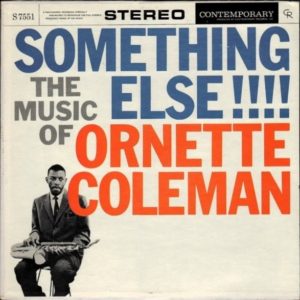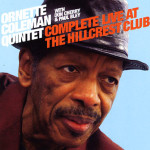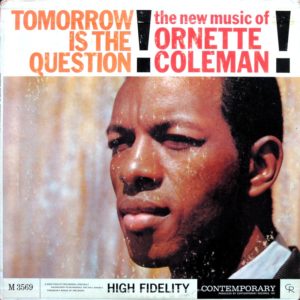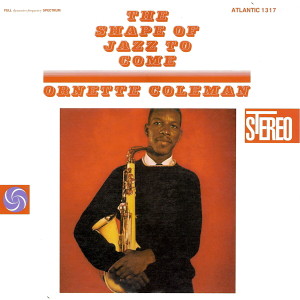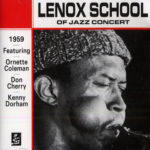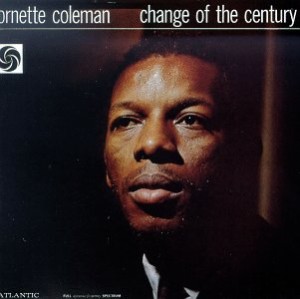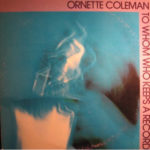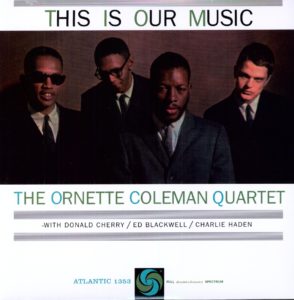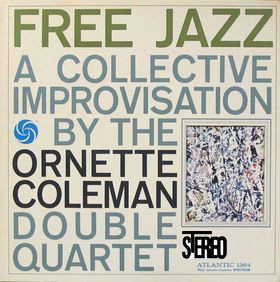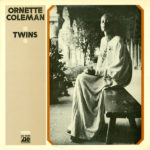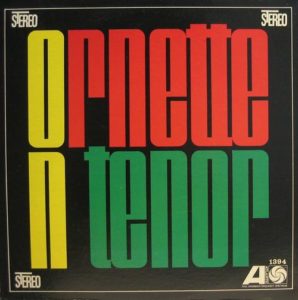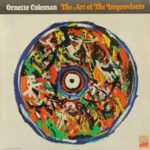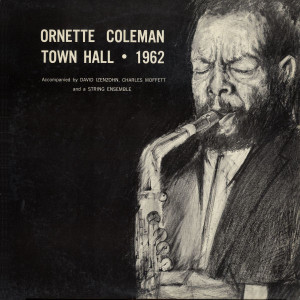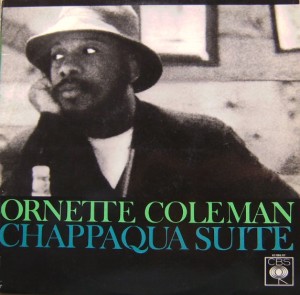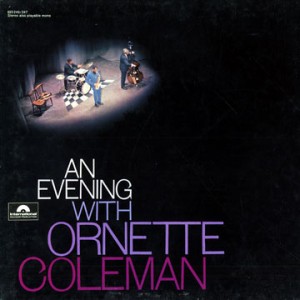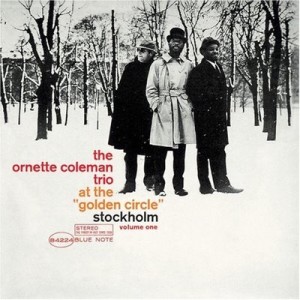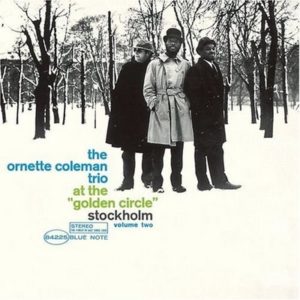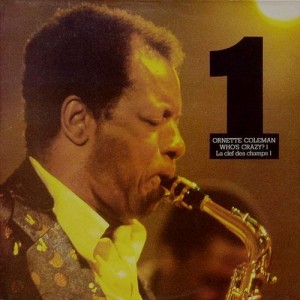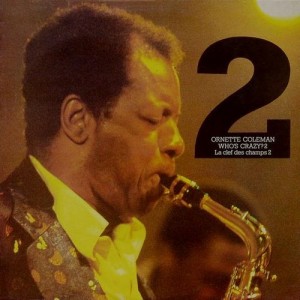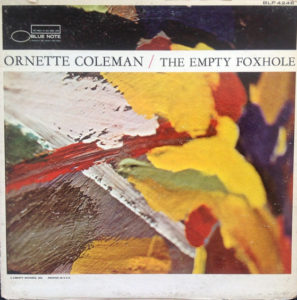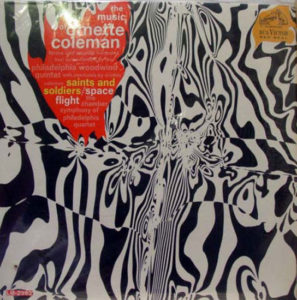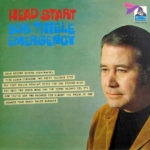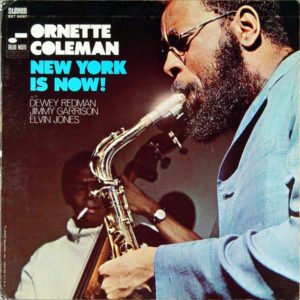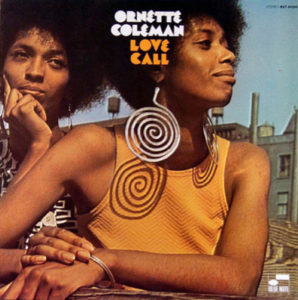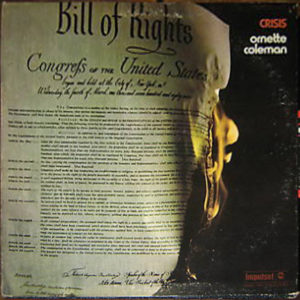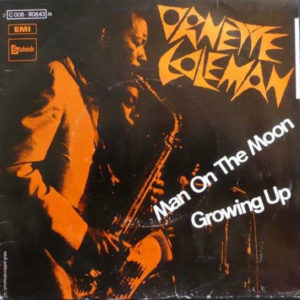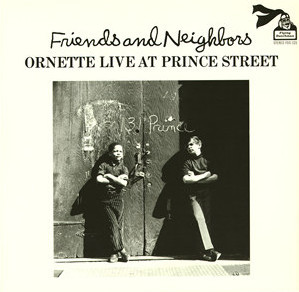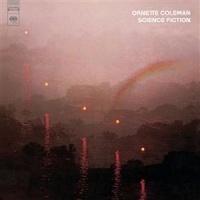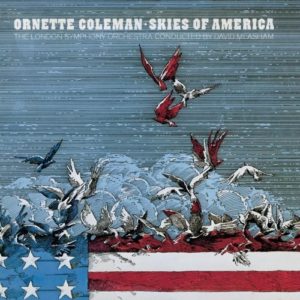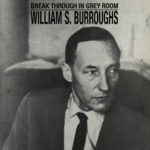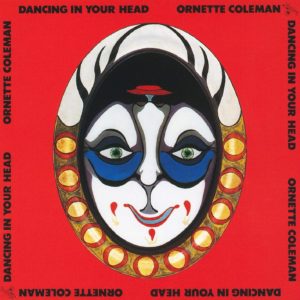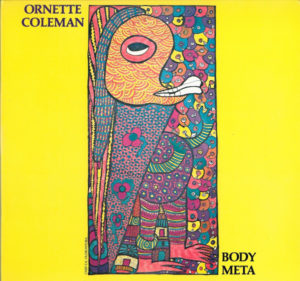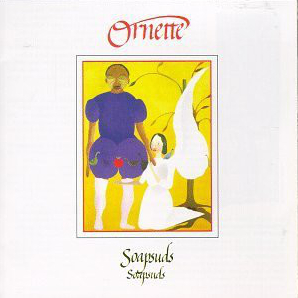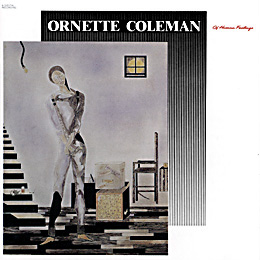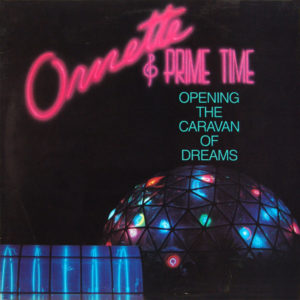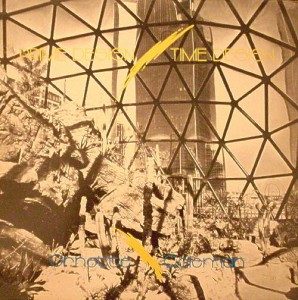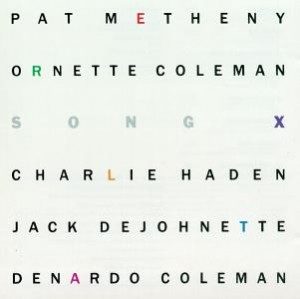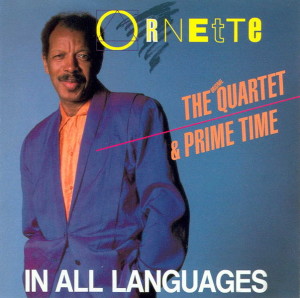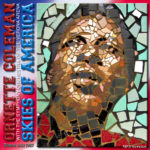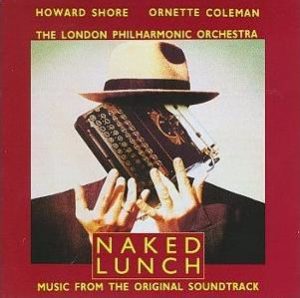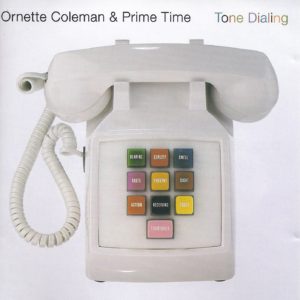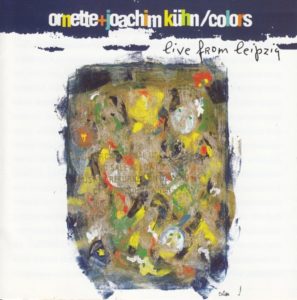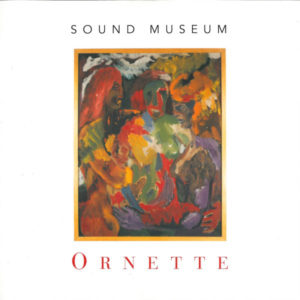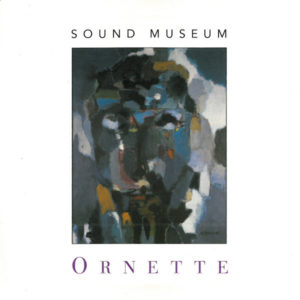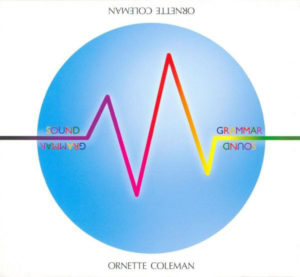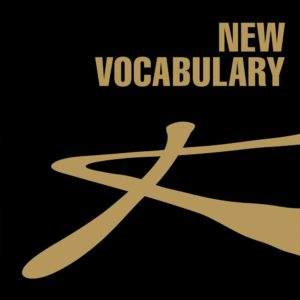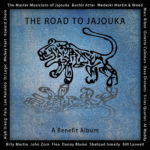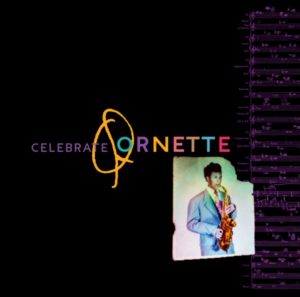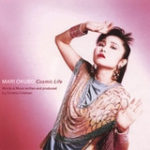A guide by Syd Fablo, Bruno Bickleby, and Patrick.
Introduction
This is a guide to the music of Ornette Coleman. Albums are listed chronologically by recording date, broken down into multiple periods of his life and career and supplemented with biographical information. Outtake and various artists collections are shown indented and with smaller font and images. Bootlegs are listed, indented, but images and details are provided for only a few selected bootlegs that are of particular significance. Guest and sideman appearances are listed separately toward the end. Book, film/video/TV, and web site resources about or featuring Ornette are listed at the end. The authors also provide curators’ picks and some other items of interest at the end. While there are some compilations and box sets of Ornette’s work available, note that (with one exception) most focus on only a narrow period of time or are explicitly record label specific — the most significant of the label-specific ones being Beauty Is a Rare Thing: The Complete Atlantic Recordings. It is somewhat unfortunate that many of Coleman’s recordings are currently out of print. Moreover, unlike the deluge of archival, outtake and bonus material issued for certain other famous musical contemporaries of Ornette, there has been comparatively little of such material by him officially released to date.
A Brief Biography
Birth Name: Randolph Denard Ornette Coleman
Born: March 19, 1930 (or possibly March 9, 1930), Fort Worth, TX.
Died: June 11, 2015, New York, NY.
Ornette received almost no formal musical training, and was a noted autodidact. Reports of him being unable to read music are often exaggerated in order to present him as a kind of primitive musical savant, rather than as someone from humble roots who willfully bucked convention. Though he began playing music professionally while still a teenager, it was not until he was in his late 20s that he recorded as a bandleader and he was almost 30 years old before he found success as a solo act — rather late by typical jazz standards. His music was resisted and disliked by many, but he showed an uncommon amount of “grit” in sticking with it despite adversities and setbacks. Listeners tend to have a “love him or hate him” sort of reaction. Usually described as shy (i.e., introverted), he also struck many as an unusual guy for his mannerisms and outlook on life. He eventually developed his own musical theory that he dubbed “Harmolodics”, which he insisted can be applied to how one conducts their own life and to other artistic forms. Often he described himself as a composer who performs. “Lonely Woman” was his first “Harmolodic” composition, and is perhaps his best-known song. One-time collaborator Pat Metheny said about him, “Ornette is the rare example of a musician who has created his own world, his own reality, his own language – effective to the point where emulation and absorbtion [sic] of it is not only impossible, it is simply too daunting a task for most musicians to even consider.” His career (and fortunes) ebbed and flowed, with periods of intense activities and long stretches of public inactivity. He nonetheless came to be regarded as one of America’s greatest musical innovators. He also had a considerable art collection, and partly due to those interests notable contemporary artworks were reproduced on many of his albums, on the cover, back and/or inserts. At least after achieving career success, he was a dapper dresser, often wearing brightly colored custom made suits. His sister Truvenza (Trudy) Coleman also had a musical career, though she did not work with her brother professionally.
Legend
🎷🎷🎷 = top-tier; an essential
🎷🎷 = second tier; enjoyable but more for the confirmed fan; worthwhile after you’ve explored the essentials and still want more
🎷 = third tier; a lesser release, for completists only
Tomorrow Is the Question: The Early Years
Ornette’s career as a professional musician began during World War II when he was still a teenager. He played in local bands at a time when adult musicians who otherwise would have held those jobs were drafted into the military. He then left home and toured (mostly in the U.S. South and Southwest) with a minstrel show and played with R&B/blues bands, including Pee Wee Crayton‘s band. His original instrument was alto sax, but he switched to tenor sax for better job opportunities and the sort of prestige it carried. After his instrument was destroyed, in an incident in Baton Rouge, Louisiana in which other musicians beat him and broke his sax as retaliation against Ornette playing his type of music, he switched back to alto. He eventually decided to pursue his own music in Los Angeles. He studied music theory on his own. Famously, he played an off-white Grafton plastic alto because he could not afford a metal horn at the time, though he played a new metal one (painted white) most of the rest of his career. His sound was also unique due to his unusually “open” reed placement on his mouthpiece, and through use of very stiff reeds. He got married in 1954 (to poet Jayne Cortez) and had his only child (Denardo Ornette Coleman) in 1956 — he separated from his wife before the late 50s and the couple formally divorced in 1964. During this period he had long hair, was a vegetarian, and briefly was a Jehovah’s Witness. Many things about him, not just his music, were out of the ordinary. For years, he was unsuccessful in finding commercial outlets for his music, and worked as a stocker and elevator operator in a department store for income. He did, however, attract some young players (some just teenagers) who regularly practiced with him in private. In this sense, his unique music was largely developed well in advance of it being recorded. He also tried to sit in with bands at clubs, usually facing much resistance and hostility towards his style of playing. But eventually he connected with Contemporary Records and was able to record — before having any sort of consistent jobs leading a band for live performances. Then he met members of The Modern Jazz Quartet, and through the intervention of their piano player John Lewis was able to secure opportunities that produced the next phase of his career. That included a new recording contract with New York City-based Atlantic Records.
Something Else!!!! The Music of Ornette Coleman (1958)
Release Notes: available in multiple formats; also on 1958-1962: The Complete Albums Collection and Six Classic Albums; available for streaming
Recorded: February 10 & 22, 1958, March 24, 1958, Contemporary Studio, Los Angeles, CA
Personnel: DC, BH, Walter Norris (piano), Don Payne (bass)
Producer: Lester Koenig
Tier: 🎷/ – / 🎷 (1.0)
Key Track(s): “Invisible”
Review:
Ornette was originally hired by Contemporary Records just as a staff composer, but was eventually given the opportunity to record. While his debut album features a few good tunes with off-kilter bebop-influenced heads (“The Blessing,” “Invisible”), the album isn’t especially effective. The rhythm section in particular is just not compatible enough with Ornette’s new ideas, still too tethered to regular bop rhythms and chord changes. The piano is more a liability than an asset. After this debut, Ornette would not make a studio recording with a piano for nearly a decade and a half! This ends up being a lesser version of the same style of music he would perfect over the next few years. This also makes a somewhat poor example of what Ornette was doing with his music in private around this time. Most listeners will want to skip past this and only revisit it after exploring the rest of the early recordings. — Syd
Bootleg
Paul Bley Quintet – Complete Live at The Hillcrest Club (2007)
Release Notes: originally released on The Fabulous Paul Bley Quintet and Coleman Classics 1; available on vinyl
Recorded: October-November, 1958, The Hillcrest Club, Los Angeles, CA
Personnel: DC, BH, CH, Paul Bley (piano)
Producer(s):
Tier: 🎷🎷 / – / 🎷🎷 (2.0)
Key Track(s): “Klactoveesedstene” and “Ramblin'”
Review:
Though these live recordings from Los Angeles are somewhat lo-fi (recorded by Carla Bley), they end up being important historical documentation and a much stronger set of performances than Ornette’s studio debut Something Else!!!! Ornette was unable to secure any regular live gigs at this time, but pianist Paul Bley, who was fascinated by Ornette’s music, had an ongoing gig at the Hillcrest Club. He invited Ornette and his regular associates to sit in, basically displacing most of his own band. So this is essentially the same Coleman quartet that would take New York by storm the following year, with the addition of Bley — formally the bandleader — to make a quintet. The songs are a mix of Coleman originals, bebop or quasi-bop tunes (“Klactoveesedstene,” “I Remember Harlem”), and a standard (“How Deep Is the Ocean”). The players’ common stylistic roots and interests in bop are on full display. But so is Ornette’s new vision of something well beyond that. The solos hold up well, especially from Ornette. Bley’s piano playing is a decent fit, despite Ornette’s well-known disdain for pianos. This music was unpopular with the club’s patrons at the time, though there is audible applause! If nothing else, these recordings prove how Ornette’s music vision was already fully developed by 1958 despite his inability to secure his own gigs or record with a fully compatible band in the studio. Also, it is worth noting that through the years Bley became one of the most articulate analysts of Ornette’s early music, particularly from the standpoint of cultural and musical history. While the bootleg quality makes this item one for newcomers to pass over initially, it is well worth investigating later on. — Syd
Tomorrow Is the Question! The New Music of Ornette Coleman! (1959)
Release Notes: available in multiple formats; also on 1958-1962: The Complete Albums Collection and Six Classic Albums; available for streaming
Recorded: January 16, 1959, February 23, 1959, March 9 & 10, 1959, Contemporary Studio, Los Angeles, CA
Personnel: DC, Shelly Manne (drums), Percy Heath (bass)
Producer: Lester Koenig
Tier: 🎷🎷 / – / 🎷🎷 (2.0)
Key Track: “Tomorrow Is the Question!”
Review:
Following his rather tepid, hesitant debut (which nevertheless served as a useful showcase for his talents), Coleman’s light shines a little brighter on his follow-up. Here, he initiates a trend that will last nearly forty years: playing in piano-less groups. Another interesting element here is the substitution of Billy Higgins with seasoned jazz veteran Shelly Manne on drums. His highly professional, multi-faceted approach serves Coleman well, though here he lacks a certain je ne sais quoi that prevents Coleman from fully realizing his vision. Without the piano, Coleman’s solos, now unmoored, are more adventurous, inventive, and abrasive than on Something Else!!!! Though it lacks the gut-punch of his Atlantic recordings, it is nearly as good as some of them. This is a less than essential release that fans becoming familiar with his discography should explore sooner rather than later. — Bruno
The Shape of Jazz to Come (1959)
Release Notes: available in multiple formats; also included on the Beauty Is a Rare Thing box set and on 1958-1962: The Complete Albums Collection and Six Classic Albums
Recorded: May 22, 1959, Radio Recorders, Hollywood, CA
Personnel: DC, CH, BH
Producer: Nesuhi Ertegun
Tier: 🎷🎷/ – / 🎷🎷🎷 (2.5)
Key Tracks: “Lonely Woman” and “Focus on Sanity”
Review:
This is generally regarded as one of the essential Ornette Coleman albums. He recorded it in L.A. for his new label Atlantic. It was actually released before his second album recorded for Contemporary. Keeping with their strategy of presenting Ornette as a radical new musician, Atlantic named this The Shape of Jazz to Come. Ornette had no role in selecting that title. This represented an improvement on the Contemporary recordings, mostly because the lineup of the quartet fell into place with a group of young, talented and — most importantly — sympathetic performers, who would also form his working band. Ornette plays in a harsh way, with a sound always about a quarter cent sharp. Don Cherry plays cornet similarly, with a knack for keeping to Ornette’s melodic lines with a characteristic phase-shift, always a split second off of Ornette’s timing. Bassist Charlie Haden plays with a warm, R&B tinge, occasionally playing double stops (“Focus on Sanity,” “Chronology”) in a fluid, buoying way that contrasts with the dissonant horns. Ornette considered Haden one of the most important musical associates he ever worked with, and his presence is a big factor in elevating this album beyond the earlier ones. Drummer Billy Higgins is basically a very forward-thinking bebop drummer, and his bop-rooted drumming helps make this is an easier listen than some of Coleman’s later albums with more free-wheeling percussion and rapidly shifting polyrhythms. The opener “Lonely Woman” is perhaps the single best-known Coleman composition, and his song most frequently covered by others. Ornette said he composed it after seeing a painting of a wealthy woman who looked sad to him. The sour, dissonant melody played on sax and cornet stumbles along, falling forward. The players are free to melodically improvise without fixed harmonic relationships to each other or a tonal center. Ornette later described this as his first “Harmolodic” composition. — Syd
This Is Our Music: Now In New York City
Ornette brought his band (a quartet) from L.A. to New York City in 1959 where they played at the Five Spot Cafe. The band was a polarizing sensation. They recorded a string of highly-regarded albums for Atlantic. Ornette studied music theory with Gunther Schuller briefly, and also gave private lessons to John Coltrane. However, after a time Ornette felt clubs would not pay him adequately, and as a result did not perform live. But he organized and self-financed a concert himself at the Town Hall, then he completely withdrew from public performance for a few years and taught himself to play trumpet and violin. One of his classical compositions, “City Minds and Country Hearts,” was nonetheless performed by David Tudor and Charlotte Moorman at the inaugural Avant Garde Festival of New York during his time away from the spotlight. Bill Dixon also organized the “October Revolution in Jazz” concerts during this period and “free jazz” started to become a distinct sub-current in the genre.
Bootleg
Various Artists – Lenox School of Jazz Concert 1959 (1990)
Release Notes:
Recorded: August 29, 1959, Berkshire Music Barn, Lenox School of Music, Lenox, MA
Personnel: Max Roach-John Lewis Ensemble: DC, Kent McGarity (trombone, bass trombone), Steve Kuhn and/or Ron Brown (piano), Larry Ridley (bass), Barry Greenspan (drums); Margo Guryan (composer); Herb Pomeroy Ensemble: Lenny Popkin (alto sax), Gary McFarland (vibrophone), Ian Underwood (flute, alto sax), Tony Greenwald (trumpet), Al Kiger (trumpet), Herb Gardner (trombone), Paul Dunyhower (trombone), David Baker (bass trombone), Ted Casher (tenor sax), Sture Swenson (bass sax), David Mackay (piano), John Keyser (bass), Paul Cohen (drums), Herb Pomeroy (conductor) [recordings featuring Ornette only]
Producer(s):
Tier: 🎷 / – / 🎷 (1.0)
Key Track(s): “The Sphinx”
Review:
In 1959, Ornette’s new label Atlantic provided scholarships for him and his associate Don Cherry to attend the Lenox School of Jazz, run by John Lewis of The Modern Jazz Quartet. Although nominally students, the pair were more like featured guests and their attendance was a kind of promotional appearance that allowed them to interact with luminaries of the New York jazz scene. The program concluded with a concert, and Atlantic recorded parts of it that were later released on bootlegs. Although the surviving recordings are unessential, Ornette’s appearance at the Lenox School of Jazz was crucial for both his own career and the “shape of jazz to come,” responsible in a substantial way for germinating the idea of him as an “important” artist and influencing the future careers of many attendees. — Syd
Change of the Century (1960)
Release Notes: available in multiple formats; also included on the Beauty Is a Rare Thing box set and on 1958-1962: The Complete Albums Collection and Six Classic Albums; “Una Muy Bonita” also released as a single
Recorded: October 8 & 9, 1959, Radio Recorders, Hollywood, CA
Personnel: DC, CH, BH
Producer: Nesuhi Ertegun
Tier: 🎷🎷/ – / 🎷🎷🎷 (2.5)
Key Track(s): “Change of the Century,” “Ramblin'” and “Una Muy Bonita”
Review:
Ornette’s second album for Atlantic Records was actually recorded back in California, though it was his last studio recording there. This sort of represents the most complete refinement of the ideas that fueled all his earlier albums. That is to say this sounds heavily influenced by bebop and hard bop, featuring songs with a composed “head” followed by traded solos, though this definitely pushes beyond the confines of genre conventions. All of the songs are medium or up-tempo numbers, and the melodies are especially catchy. If nothing else this album makes a great example of Ornette’s skills as a composer of songs. The band had a great rapport by this point, and they play with as much polish as ever. After this record, Ornette would start to add in a few compositions and performances on his albums that pushed into new areas and were less bebop influenced. This album was initially relatively commercially successful, for a modern jazz album at least. Listeners familiar with bop might try this album first — indeed, some more conservative/traditional listeners’ interest stops here. — Syd
To Whom Who Keeps a Record (1975)
Release Notes: outtakes from the Change of the Century and This Is Our Music sessions; available on CD and digitally; also included on the Beauty Is a Rare Thing box set
Recorded: October 8, 1959, Radio Recorders, Hollywood, CA; July 19 & 26, 1960, Atlantic Studios, New York, NY
Personnel: DC, CH, EB
Producer: Nesuhi Ertegun
Tier: – / – / 🎷 (1.0)
Key Track(s): “P.S. Unless One Has (Blues Connotation No. 2)” and “To Us”
Review:
In the 1970s Atlantic Records began releasing albums of outtakes from recording sessions in the 50s and 60s. Ornette has groused that he did not authorize them — a complaint he registered against a surprising number of other releases too. Although this particular album shows up as being unauthorized in some discographies, Ornette did personally select the song titles so that when sequenced as they appear on this album they form a complete sentence: “Music always brings goodness to us all, P.S. unless one has some other motive for its use.” Anyway, most artists can only dream of rejected tracks this good, though none of these outtake albums can match the original Atlantic albums. Often the problem is that tracks have a flat performance from one of the sidemen. To Whom Who Keeps a Record was the last of the Atlantic outtake sets released (exclusively in Japan), but focused on material from the earliest sessions and has a bit more bebop influence. — Syd
This Is Our Music (1961)
Release Notes: available on CD and digitally; also included on the Beauty Is a Rare Thing box set and on 1958-1962: The Complete Albums Collection and Six Classic Albums; [additional track “The Tribes of New York” from the same sessions on Beauty Is a Rare Thing]
Recorded: July 19 & 26, 1960, August 2, 1960, Atlantic Studios, New York, NY
Personnel: DC, CH, EB
Producer: Nesuhi Ertegun
Tier: 🎷🎷🎷/ – / 🎷🎷🎷 (3.0)
Key Track(s): “Blues Connotation” and “Beauty Is a Rare Thing”
Review:
Although Ornette and his band had already relocated to New York City, This Is Our Music was the first studio recording he made in New York. Drummer Billy Higgins lost his cabaret card (essential for live performers in New York City at the time). That loss turned into a gain by providing Ornette with the opportunity to reunite with the innovative New Orleans drummer Ed Blackwell, who moved the group’s rhythmic structure further away from bebop. This is one of the essential Ornette albums. It opens with the stupendous “Blues Connotation,” a song that draws from his background playing in R&B bands, and demonstrates how he placed things like R&B/blues on the same level as jazz or any other genre — he implicitly refused to draw distinctions between highbrow/middlebrow/lowbrow forms. The melody has an innocent, childlike simplicity, though this was not some sort of retreat to a fantasy of a safe and secure childhood but rather is about mature adult things, the sort of music that is beyond the capacity of infant children. Yet it is an argument that mature adult topics should include a space for innocence and simplicity and goodness. “Beauty Is a Rare Thing” is a slower tune that is an early example of Ornette’s interest in orchestral composition. Many cite that song as a kind of exemplar of the “free” aspects of Ornette’s music. Some other songs reference bebop influences. “Embraceable You” is a rare standard (rare for Coleman albums that is). It gets an appropriately sarcastic reading, complete with the horn players offering swaying, almost staggering lines, at times like a band playing gag lines to get a rise from the audience. Basically, this is the best small combo lineup of the Atlantic years, with the band firing on all cylinders, and the songs are varied and all top-notch. — Syd
Free Jazz: A Collective Improvisation (1961)
Release Notes: available in multiple formats; also included on the Beauty Is a Rare Thing box set and on 1958-1962: The Complete Albums Collection and Six Classic Albums
Recorded: December 21, 1960, A&R Studios, New York, NY
Personnel: DC, CH, SL, EB, BH, Eric Dolphy (bass clarinet), Freddie Hubbard (trumpet)
Producer: Nesuhi Ertegun
Tier: 🎷🎷🎷/ – / 🎷🎷🎷 (3.0)
Key Track(s): [the entire album is a single piece]
Review:
Free Jazz is an album much like Never Mind the Bollocks, Here’s the Sex Pistols insofar as its reputation precedes it, often to its detriment. When people first hear the Sex Pistols, especially after hearing some of the voluminous amounts of punk rock that appeared after 1977, the group can seem quite quaint by comparison to, say, Minor Threat or Black Flag. Similarly, those who have listened to their fair share of free jazz by artists such as Albert Ayler, Pharoah Sanders, or Charles Gayle without making their way through the Ornette Coleman album of the same name can be disappointed. The thing is: both albums are masterpieces of innovation and execution.
“Free jazz” wasn’t invented by Ornette Coleman. His album put a name to a particular style of improvisational playing that hadn’t previously existed. However, free jazz existed, undocumented, in numerous jazz clubs for decades prior to the appearance of this recording, though its impact was limited at best. As documented on recordings, many jazz historians cite Lennie Tristano and His Sextette‘s “Intuition” (1950) as the first recorded free jazz performance. In the years immediately preceding the release of Free Jazz, innovators such as Sun Ra, Cecil Taylor, and Charles Mingus (particularly on Pithecanthropus Erectus [1956]) were already exploring this space. The release of Coleman’s album in 1961 spawned a movement, highlighted in the succeeding years by Albert Ayler, Pharoah Sanders, Charles Gayle, Peter Brötzmann, and many many others. While Coleman’s record may today sound almost quaint compared to those followed, it sets up a few parameters that many if not most of these artists would obey moving forward.
If Coleman’s first two albums for the Atlantic label were seen as revolutionary at the time, because they in fact were, it is quite difficult to imagine how listeners responded when they first heard Free Jazz: A Collective Improvisation back in 1961. Coleman utilizes a “double quartet,” doubling his core band, adding the brilliant musicians Eric Dolphy, Freddie Hubbard, Ed Blackwell, and Scott LaFaro, who passed away not long after this album was recorded. In principle, this 38-minute performance doesn’t stray too far from The Shape of Jazz to Come or Change of the Century. A head melody is introduced, then a band member takes a solo. What makes this album so different is that the soloists are often joined by other soloists in a kind of conversation completely untethered to the chord progressions of traditional jazz. One of the weaknesses of Coleman’s early records is that there is often too much space during solos, leading to occasional stagnancy. On Free Jazz, multiple simultaneous soloists are complementing each other, and the result is a polyphonous performance, grounded in the rhythm section, that rarely devolves into the pure chaos that highlights much of the free jazz that would follow in this album’s wake. The rhythm section solos on Side Two of the original vinyl release are especially compelling. Going back to the first sentence of this entry, Free Jazz can be a shock to listeners familiar with his core Atlantic recordings. Furthermore, listeners who have already exposed themselves to the later titans of free jazz might find it not abrasive enough! Though divisive, the album is still one of the more powerful jazz recordings in existence, one whose outsized influence continues to this very day. — Bruno
Ornette! (1962)
Release Notes: available in multiple formats; also included on the Beauty Is a Rare Thing box set, 1958-1962: The Complete Albums Collection and A Meeting of the Times / Ornette!; [additional track “Proof Readers” from the same sessions on Beauty Is a Rare Thing]; the song titles are acronyms or abbreviations for books by Sigmund Freud: Wit and Its Relation to the Unconscious [1905] also translated as Jokes and Their Relation to the Unconscious (“W.R.U.”), Totem & Taboo: Resemblances Between the Psychic Lives of Savages and Neurotics [1913] (“T & T”), Civilization and Its Discontents [1930] (“C & D”), and Relation of the Poet to Day Dreaming [1908] also translated as Creative Writers and Day-Dreaming (“R.P.D.D.”)
Recorded: January 31, 1961, Atlantic Studios, New York, NY
Personnel: DC, SL, EB
Producer: Nesuhi Ertegun [supervisor]
Tier: 🎷🎷/ – / 🎷🎷 (2.0)
Key Track(s):
Review:
After several consecutive albums of almost dizzying innovation, Coleman takes a slight step back with Ornette! It’s almost as if he is starting to get bored with his Quartet set-up. At this point, his playing on the alto saxophone is as good as it had been up to that point. Cherry’s trumpeting shows continued signs of improvement as well. But after a few years of constant performing, and performing under the strain of being the controversial “next big thing” in jazz, the inspiration seems lacking from this one. Oddly enough, some listeners might find it more engaging than his previous efforts for Atlantic, in part because Coleman’s group is playing at a high-level, state-of-the-art musical autopilot. It should be noted that Charlie Haden is out here, owing to substance use issues, replaced by Scott LaFaro. LaFaro is brilliant, but he never gels with Coleman the way Haden does. In short, Ornette! is probably one of his most accessible albums, even if Coleman’s usual inventiveness remains somewhat in check on it. — Bruno
Twins (1971)
Release Notes: available in multiple formats; also included on the Beauty Is a Rare Thing box set
Recorded: May 22, 1959, Radio Recorders, Hollywood, CA; July 19 & 26, 1960, Atlantic Studios, New York, NY; December 21, 1960, A&R Studios, New York, NY; January 31, 1961, Atlantic Studios, New York, NY
Personnel: DC, CH, BH, EB, SL, Eric Dolphy (bass clarinet), Freddie Hubbard (trumpet)
Producer: Nesuhi Ertegun
Tier: 🎷🎷 / – / 🎷🎷 (2.0)
Key Track: “First Take”
Review:
Twins is yet another collection of outtakes issued by Atlantic long after Coleman had left the label (and against his wishes). This one is notable for containing the “first take” of Free Jazz, which is quite compelling in its own right, despite being half as long. This version offers proof of Coleman’s brilliance as an arranger and a composer. The remaining four takes are culled from three different lineups, making this a tonally inconsistent batch of recordings. It does offer proof that even Coleman’s leftovers at the time were solid. — Bruno
Ornette on Tenor (1962)
Release Notes: available in multiple formats; also included on the Beauty Is a Rare Thing box set and on 1958-1962: The Complete Albums Collection
Recorded: March 22 & 27, 1961, Atlantic Studios, New York, NY
Personnel: DC, JG, EB
Producer: Nesuhi Ertegun [supervisor]
Tier: 🎷🎷/ – / 🎷🎷 (2.0)
Key Track(s):
Review:
A sort of musical ennui is present on Ornette! Coleman challenges himself on its follow-up, the aptly titled Ornette on Tenor, by switching horns. He had not played tenor saxophone in a decade, so the change is the first of many Coleman experiments with non-alto saxophone instruments. Once again, Coleman relies on a different bassist, this time Jimmy Garrison from the newly formed John Coltrane Quartet. Garrison’s performance on this one gets a bad rap. In all fairness, his playing is fine, but, like LaFaro’s on the previous record, it just can’t match the instinctive ebb and flow of Haden’s complementary voice to Coleman’s horn. Though Ornette! is easier to enjoy than this album, Ornette on Tenor is more refreshing because of the subtle changes Coleman makes in his playing to accommodate the different horn. The sweet and sour tone his is famous for on the alto saxophone becomes more assertive here, but less lyrical. Though Coleman’s last two efforts for Atlantic are the least “revolutionary” of the batch, they are still solid entries in his voluminous discography. — Bruno
The Art of the Improvisers (1970)
Release Notes: available in multiple formats; also included on the Beauty Is a Rare Thing box set
Recorded: May 22, 1959, October 9, 1959, Radio Recorders, Hollywood, CA; July 26, 1960, Atlantic Studios, New York, NY; January 31, 1961, March 27, 1961, Atlantic Studios, New York, NY
Personnel: DC, CH, BH, EB, SL, JG
Producer: Nesuhi Ertegun
Tier: 🎷🎷/ – / 🎷 (1.5)
Key Track(s):
Review:
Town Hall, 1962 (1965)
Release Notes: available in multiple formats
Recorded: December 21, 1962, The Town Hall, New York, NY
Personnel: DI, CM, Selwart Clarke (violin), Nathan Goldstein (violin), Julian Barber (viola), Kermit Moore (cello)
Producer: Ornette Coleman [uncredited]
Tier: 🎷🎷/ – / 🎷🎷🎷 (2.5)
Key Track(s): “Sadness”
Review:
Ornette opposed his treatment by nightclubs, and for a time stopped performing in them, nominally disputing payment terms. He also voiced criticism of the way jazz had historically been wedded to the economies of booze and sex when presented at nightclubs and burlesque houses. Clubs showed declining interest in jazz at this time anyway. Atlantic Records had also dropped him due to low sales, despite strong early sales of albums like Change of the Century. But in 1962 he formed a new trio with classical/jazz bassist David Izenzon and drummer Charles Moffett, and organized his own concert at New York’s Town Hall. At the time, Town Hall was the number two concert hall in New York, after Carnegie Hall. It was a venue for serious concerts. Ornette self-financed the show, and he and band members put up posters themselves to advertise it. Even apart from the music presented, the pursuit of self-directed concert promotion proved hugely influential to other artists. The concert was recorded by Blue Note Records, which had intended to release the concert recordings in two volumes but turned over the tapes to Ornette following rights disputes. A selection of some of the performances then appeared on a single-disc album released by ESP-Disk’. The show was eclectic if nothing else. Ornette’s group played a varied assortment of free jazz as well as an R&B number with Nappy Allen’s Rhythm and Blues Trio (not on the album), and a string quartet played one of his modern classical compositions. The music represented a significant break from his work as a bandleader to this point. It also mapped out much of his work over the rest of the 1960s. Izenzon was a gracious performer who was very comfortable operating independently of Ornette and Moffett in a kind of simultaneous soloing rather than comping role. Moffett — whom Ornette knew growing up in Texas — played with hints of bop but also an incongruous, shifting deployment of cymbal rides and other discrete techniques at unconventional times in relation to what Ornette and Izenzon were doing. The opener “Doughnut” is the basic template for much of the trio’s later work. “Sadness” is a slow, morose piece with an appropriate title, with Izenzon playing microtones arco (bowed) on his bass. “The Ark” is a long, loose performance that points toward Chappaqua Suite. “Dedication to Poets and Writers” is a modern classical composition. While perhaps not as mature a piece as some of his later classical compositions, it does reveal an affinity to Third Stream composers and the Second Viennese School, and the performance by the string quartet is excellent. Sun Ra perplexed audiences when he juxtaposed swing, sci-fi exotica and free jazz, and Ornette faced a little of the same with his own genre shifts and juxtapositions. But the extremely meritocratic posture and disregard for “credentials” embodied in this concert and accompanying recording are quite characteristic of Ornette. This one might not be for everyone, but many who like it tend to really love it. — Syd
Bootleg(s)
Ornette at Town Hall, Vol 1 & Vol 2
Release Notes:
Recorded: December 21, 1962, The Town Hall, New York, NY
Personnel: DI, CM, Selwart Clarke (violin), Nathan Goldstein (violin), Julian Barber (viola), Kermit Moore (cello)
Producer(s):
Tier: – / – / 🎷🎷🎷 (3.0)
Key Track(s):
Review:
Friends & Neighbors: Return to Public Performance
After a period of semi-retirement, Ornette returned to public performance at New York City’s Village Vanguard in January of 1965, with the same trio from his last public performance at Town Hall in 1962. He then accepted a commission to record a soundtrack to the film Chappaqua. Ornette used the money obtained for that soundtrack work to fund a trip for his group to Europe. The resultant tour was successful and garnered Ornette international (and domestic) recognition. He returned to Europe multiple times in the late 1960s. This was a period of expansion of his musical ideas, and a time of growing commercial success. For instance, he composed numerous modern classical pieces, worked on a variety of soundtracks, and developed connections to a variety of artists from around the world. He purchased a loft on Prince Street in New York City, named it “Artists House” (or a variation on that name), and began to host events there — something he had earlier attempted elsewhere too. Although legal disputes ended his plans for more concerts at Artists House, he contributed some inspiration for the loft jazz scene of the mid-to-late 70s. He worked with a number of different record labels during this time, and, unfortunately, many of the recordings from this era have been out of print much of the time.
Chappaqua Suite (1967)
Release Notes: Out of print
Recorded: June 15–17, 1965, New York, NY
Personnel: DI, CM, Pharoah Sanders (tenor sax), Joseph Tekula (conductor), [11-piece studio orchestra of unidentified performers]
Producer: Henri Renaud
Tier: 🎷🎷/ – / 🎷🎷 (2.0)
Key Track(s):
Review:
Somewhat of an overlooked oddity in the Ornette Coleman catalog, viewed in hindsight, Chappaqua Suite is actually stronger than a lot of other mid/late 1960s Coleman recordings. This was intended to be a film soundtrack, but was never actually used with the film. It features orchestral backing in places. Ornette is right out in front where he belongs. His playing is good too, even if the sheer length of the performances occasionally wears him down a touch. There are passages lifted from familiar tunes, though most of this seems new. What is particularly amazing about this is how Ornette saw a fairly conventional European orchestra as something that could be seamlessly integrated into his musical vision, without compromising anything. It was a quality that made Ornette great. Sure, he was the face of the movement to “break away” from the “rules” that governed jazz music. But his real genius was his foresight to break the rules in order to go back the the source of the rules and work with the raw material. He saw a European-style orchestra as something that could be used in a different cultural setting. This is music that suggests that everybody can get along, and difference, rather than sameness, can be a central element of a musical vision. One quality stands out. This is music of confidence. Every moment exudes belief it is just another step toward changing the world. It seems to possess limitless energy toward that end. It may be only one step in a long march. But those first few steps are always the most challenging. The reasons this remains an oddity are twofold. This was originally a French-only release, which limited its exposure to much of Coleman’s fan base. It also was a double-LP album mastered as four side-long pieces identified just as Parts I-IV, which, combined with Coleman’s typical and characteristic meanderings, makes this more difficult for some to digest. — Syd
An Evening With Ornette Coleman (1967)
Release Notes: AKA The Great London Concert, Ornette Coleman in Europe Vols. I & II, Sadness, I Grandi Del Jazz, Croydon Concert
Recorded: August 29, 1965, Fairfield Halls, Croydon, London, England, UK
Personnel: DI, CM, Virtuoso Ensemble: Edward Walker (flute), Derek Wickers (oboe), John Burden (English horn or flugelhorn), Cecil James (bassoon), Sidney Fell (clarinet)
Producer: Alan Bates
Tier: 🎷 / – / 🎷 (1.0)
Key Tracks: “Falling Stars” and “Silence”
Review:
The problem with An Evening with Ornette Coleman (which has, unfortunately, been reissued with a confusing array of different titles and configurations) is that it is a bit redundant. The neo-classical composition that takes up the entirety of Side One bares some resemblance to “The Ark” which appears on Town Hall 1962 (a superior, albeit modified, version of this composition appears on The Music of Ornette Coleman), as do the numbers “Sadness” and “Doughnuts.” The previously unreleased recordings found here foreshadow the material found on the superior two-volume set for Blue Note, At the “Golden Circle” Stockholm. Those two albums feature a more seasoned version of Coleman’s trio at the time (with David Izenzon on bass and Charles Moffett on drums), as Evening was recorded several months earlier. The highlight of the album is “Falling Stars,” which features some of Coleman’s most free and angry playing. “Silence,” with its myriad interruptions, is also a key track. The rest falls a little bit below the standard Coleman had set on his Atlantic recordings. — Bruno
Sonny Rollins Trio / Ornette Coleman Trio – The Paris Concert (see also The Paris Concert ’65)
At The “Golden Circle” Stockholm, Volume One (1966)
Release Notes: in print in multiple formats; bonus tracks from the same performances are included on the Rudy Van Gelder Edition
Recorded: December 3 & 4, 1965, Gyllene Cirkeln club, Stockholm, Sweden
Personnel: DI, CM
Producer: Francis Wolff
Tier: 🎷🎷 / – / 🎷🎷🎷 (2.5)
Key Track(s): “Faces and Places”
Review:
Though Ornette grew to disfavor jazz clubs in the USA, his trio really hit its stride amidst a 1965-66 European tour when it played Stockholm’s Gyllene Cirkeln [“Golden Circle”] club. The group plays fairly clean lines, and there is no second horn alongside Ornette’s sax, eliminating the dissonant sax/trumpet harmonies of the early 60s. By this point Ornette’s music downplayed distinct opening and closing “heads” bookending traded solos. Instead the characteristic nursery-rhyme like melodies modulate across almost the entire song with rather open-ended and elastic yet supportive accompanying soloing laced throughout on bass and drums. These performances have a sunniness and good-natured quality to them that makes them relatively approachable. Released on Blue Note Records, both the “Golden Circle” discs have remained in print more than most of Ornette’s recordings. Many dedicated fans cite these companion albums as their gateway into Ornette’s music — an honor generally rivaled only by the Atlantic albums. These discs also tend to find comparatively better reception among Ornette’s detractors than some of his other recordings. — Syd
At The “Golden Circle” Stockholm, Volume Two (1965)
Release Notes: available on CD and digitally; bonus tracks included on the Rudy Van Gelder Edition
Recorded: December 3 & 4, 1965, Gyllene Cirkeln club, Stockholm, Sweden
Personnel: DI, CM
Producer(s): Francis Wolff
Tier: 🎷🎷/ – / 🎷🎷🎷 (2.5)
Key Track: “Snowflakes and Sunshine”
Review:
(See the review for Volume One.) Volume Two differentiates itself from its counterpart by including Coleman’s first officially released performance on trumpet and violin, “Snowflakes and Sunshine.” Though probably perceived a bit of a curiosity at the time, Coleman would play at least one track on trumpet or violin on most of his subsequent recordings. Certain musicians were quite vocal in their distaste for Coleman’s extra-saxophonic experiments, most notably Miles Davis. However, a cursory understanding of Coleman’s theory of harmolodics and his exploratory approach to his own music make these attempts at non-mastery seem like a logical musical conclusion for Coleman. (Keep in mind that Davis later played keyboards during his mid-1970s fusion period.) — Bruno
The Paris Concerts 1965-1966 (see also Paris, France)
Who’s Crazy? 1 – La clé des champs 1 (1979)
Release Notes: Out of print; was also released as a compilation of vols. 1 and 2
Recorded: late 1965 or early 1966, Paris, France (most likely Nov. 1965)
Personnel: DI, CM
Producer(s):
Tier: – / – / 🎷🎷 (2.0)
Key Track(s):
Review:
Who’s Crazy? 2 – La clé des champs 2 (1979)
Release Notes: Out of print; was also released as a compilation of vols. 1 and 2
Recorded: late 1965 or early 1966, Paris, France (most likely Nov. 1965)
Personnel: DI, CM
Producer(s):
Tier: – / – / –
Key Track(s):
Review:
The Empty Foxhole (1967)
Release Notes: available on CD and digitally; available for streaming
Recorded: September 9, 1966, Van Gelder Studio, Englewood Cliffs, NJ
Personnel: CH, DOC
Producer: Francis Wolff
Tier: 🎷/ – / 🎷🎷 (1.5)
Key Track(s): “Sound Gravitation”
Review:
One could argue that The Empty Foxhole is the most radical experiment in Coleman’s voluminous discography. Why? Well, on this one, he fully embraces playing the trumpet and the violin, non-saxophone instruments which he would continue to play throughout his career, despite lacking the “training” on these instruments he received on the alto and tenor saxophones. However, the most controversial aspect of the album is his use of his ten-year-old son Denardo as the LP’s drummer. The decision seems exploitative to some critics. On the other hand, Coleman’s embrace of the non-expert musician here is an informative one. It reveals that Coleman’s music thrives — and often succeeds (though not necessarily here) — in the midst of adversity and in the embrace of musical challenges. That all being said, The Empty Foxhole is basically a palate-cleanser, a hitting of the musical reset button. Denardo’s drumming is subpar, clearly no match for that of Billy Higgins or Ed Blackwell. However, his suspect timekeeping liberates Coleman from his strengths, resulting in more explorative, albeit more tentative playing. The album’s centerpieces, the sensational “Sound Gravitation” and the nearly-as-good “Freeway Express,” yield some of Coleman’s freest playing between Free Jazz and his mid-career masterpiece Science Fiction. This momentum is not sustained throughout the remainder of the LP, resulting in an effort far more interesting than it is good. — Bruno
Ornette Coleman Trio
The Music of Ornette Coleman (1967)
Release Notes: also known as Forms and Sounds or Saints and Soldiers; available on The Music of Ornette Coleman & Skies of America
Recorded: March 17, 1967, Village Theatre, New York, NY; March 31, 1967, New York, NY
Personnel: The Philadelphia Woodwind Quintet: Mason Jones (French horn), Murray Panitz (flute, piccolo), John de Lancie (oboe, English horn), Bernard Garfield (bassoon), Anthony Gigliotti (clarinet, bass clarinet); The Chamber Symphony of Philadelphia Quartet: Stuart Canin (violin), William Steck (violin), Carlton Cooley (viola), William Stokking (cello)
Producer: Howard Scott
Tier: 🎷🎷/ – / 🎷🎷🎷 (2.5)
Key Track(s): “Forms and Sounds”
Review:
Ornette turned to “classical” composition periodically. Fans tend to have mixed views on that particular aspect of his music, though. His composition style — often writing for string or woodwind quartets and quintets — bore a striking resemblance to composers of the Second Viennese School, especially Arnold Schönberg. Arguably the most successful recordings of Ornette’s “classical” compositions are on the live album The Music of Ornette Coleman. He reworked “Forms and Sounds” to include himself on trumpet interludes, and it is realized impressively here (much more so than the first recording on An Evening With Ornette Coleman). The players are able to move about rather independently from each other, making dense, atonal/pantonal music that utilizes a lot of dissonance. The other compositions are less explicitly innovative but are still good and display Ornette’s characteristically flippant irreverence toward tradition and “respectable”/”proper” social structures (“Saints and Soldiers”), as well as his penchant for techno-futurist optimism (“Space Flight”). While some dismiss this because it is outside the realm of jazz, and others because it seems redundant of Schönberg, listeners who can set aside such preconceptions may appreciate this as daring and impassioned music. — Syd
Bob Thiele Emergency – Head Start (1969)
Release Notes: available on CD; the Ornette track was recorded at John Coltrane‘s funeral service
Recorded: July 21, 1967, St. Peter’s Lutheran Church, New York, NY [some material only]
Personnel: CH, DI, CM [material featuring Ornette only]
Producer(s):
Tier: – / – / 🎷 [Ornette material only] (1.0)
Key Track(s): “Holiday for a Graveyard”
Review:
Shortly after relocating to New York, Ornette gave private lessons to John Coltrane. Ornette had a big influence on Coltrane, whose music increasingly moved in the direction suggested by Ornette and other “free” players. Shortly before Coltrane died from liver cancer in 1967, he explicitly requested that Ornette’s group perform at his funeral. The funeral service took place at St. Peter’s Lutheran Church in New York, and opened with the Albert Ayler Quartet performing “Love Cry / Truth Is Marching In / Our Prayer” (available on Holy Ghost) and concluded with Ornette’s quartet performing “Holiday for a Graveyard.” The Ornette song was recorded and then released a few years later on the album Head Start. The live recording is lo-fi and does not add any particularly new insights to the other trio and quartet recordings (including bootlegs) available from this era. The album it is collected on is of interest, though, offering an intriguing snapshot of American culture and jazz music and the forces that shaped it — it features an audio collage with spoken passages by and about Martin Luther King, Jr. and other events (laced through with electronic music) concluding a side-long tribute to Coltrane, shows photos of the assassinated Kennedy brothers John and Robert as well as the Black Panthers, has a side-long “The Story of Jazz” audio history (reminiscent a bit of Phil Cohran & The Artistic Heritage Ensemble‘s The Malcolm X Memorial), and opens with an LP side of funky contemporary jazz that screams “groovy, man!” The rest of the album is interesting in contextualizing Ornette’s work in the late 1960s. — Syd
Live In Milano 1968 [A/K/A Languages]
Bootleg
The Unprecedented Music Of Ornette Coleman (1977)
Release Notes: also available on The Love Revolution: Complete 1968 Italian Tour
Recorded: February 8, 1968, Rome, Italy
Personnel: CH, DI, CM
Producer(s):
Tier: 🎷🎷🎷 / – / 🎷🎷 (2.5)
Key Tracks: “Lonely Woman” and “Buddha Blues”
Review:
This might be the best straight-up unauthorized release attributed to Coleman. It features a somewhat unusual lineup for Coleman in that Charlie Haden appears alongside then Coleman-regular David Izenzon on bass. The elasticity provided by the two-bass lineup, along with the concert format, makes for an especially interesting version of “Lonely Woman.” Another notable track is “Buddha Blues,” which features one of Coleman’s only forays into the shenai, resulting in some of his most explicitly Eastern-sounding music. Though this one might take some rooting around to find, it is totally worth it for seasoned fans of Coleman’s work. For this listener, it might just be his best recording with the Izenzon/Moffett lineup. — Bruno
Yoko Ono – Yoko Ono/Plastic Ono Band (1970)
Release Notes: available on CD and vinyl; available for streaming
Recorded: February 29, 1968, Royal Albert Hall, London, England, UK [recording featuring Ornette only]
Personnel: CH, DI, EB, Yoko Ono (vocals) [recording featuring Ornette only]
Producer: Yoko Ono and John Lennon
Tier: 🎷🎷 / – / 🎷 [Ornette piece only] (1.5)
Key Track: “AOS” [from “Emotion Modulation”]
Review:
When Ornette returned to the UK on tour in 1968 he once again ran up against protectionist musician’s union restrictions. The first such problem he encountered before the An Evening With Ornette Coleman concert, which forced him to write “Forms and Sounds” on short notice to qualify for a loophole in the regulations for “concert artists” — other organizers of the concert were blacklisted by the union. On his return trip he had to write another “classical” composition to once again be reclassified as a concert artist. That new composition was “Emotion Modulation.” He performed it in London. A backstage rehearsal was recorded and released on Yoko Ono’s Plastic Ono Band album, though really the performance was by Ornette’s band with Ono just sitting in. Ornette had been friends with Ono since the early 60s. Her vocals are, er, distinctive. She claimed that her wordless shrieks were inspired by women in childbirth. Ono was a like-minded “outsider” artist, though, unlike Ornette, she came from a privileged background and then of course became independently wealthy through her marriage to Beatle John Lennon. Ornette later invited her and a different iteration of her Plastic Ono band to perform at the 2009 Meltdown Festival that he curated. In the late 1990s, Ornette also brought Mari Okubo, a vaguely Ono-like singer, into his touring band. The “AOS” piece here is quite different from the avant-garde funk rock of the rest of Ono’s (rather excellent) album. The one Ornette rehearsal outtake is maybe the least interesting track and really for completists only. — Syd
New York Is Now! (1968)
Release Notes: available on vinyl and digitally; available for streaming; Mel Fuhman provided vocal overdubs on “We Now Interrupt for a Commercial” that were omitted in favor of the band’s original vocals for reissues
Recorded: April 29, 1968, May 7, 1968, A&R Studios, New York, NY; plus later vocal overdubs
Personnel: DR, JG, EJ, Mel Fuhrman (vocals)
Producer: Francis Wolff
Tier: 🎷 / – / 🎷 (1.0)
Key Tracks: “Broad Way Blues” and “The Garden of Souls”
Review:
Here’s an uneven album from a time when Ornette was experimenting with new approaches that only occasionally worked. Basically this album pairs Ornette and frequent associate Dewey Redman with John Coltrane‘s old rhythm section. While Jimmy Garrison had played with Ornette before, he has a noticeably hostile attitude here. “Broad Way Blues” is kind of a throwback to the kinds of songs Ornette wrote in the late 50s and early 60s, and is the most memorable thing here. The opener “The Garden of Souls” fits more in line with Ornette’s late 60s experimentation, and has many good things going for it, including a strong showing from Redman. But the rest of the album is very disappointing. This is among Ornette’s least satisfying albums. — Syd
Love Call (1971)
Release Notes: available in multiple formats
Recorded: April 29, 1968, May 7, 1968, A&R Studios, New York, NY
Personnel: DR, JG, EJ
Producer: Francis Wolff
Tier: 🎷 / – / 🎷🎷 (1.5)
Key Track: “Airborne”
Review:
Looking at the album cover, one might be forgiven for thinking Love Call represented Ornette diving into soul jazz or unveiling an early iteration of his Prime Time band’s forays into jazz/rock fusion. Hardly! This is actually very much in line with the music Ornette was making in the mid-to-late 1960s. It retains some of the melodic focus of the mid-60s trio recordings, yet maintains a looseness despite the added presence of Dewey Redman as a second horn player, who rarely plays simultaneously with Ornette. It opens with the best song, “Airborne,” which Ornette regularly played in concerts through the early 70s. Recorded at the same 1968 sessions as New York Is Now! but shelved until 1971, Love Call actually ends up being the more rewarding album overall. Quite frankly, though, a single disc album with only the best material from this and New York Is Now! would have made for a better presentation. — Syd
Ornette At 12 (1969)
Release Notes: available on Ornette at 12 / Crisis; the concert at which this album was recorded included a performance of “Sun Suite of San Francisco” with Ornette conducting a 25-piece orchestra that is omitted from the album
Recorded: August 11, 1968, Hearst Greek Amphitheater, University of California—Berkeley, Berkeley, CA
Personnel: DR, CH, DOC
Producer(s):
Tier: 🎷🎷 / – / 🎷🎷 (2.0)
Key Track(s): “C.O.D.” and “New York”
Review:
Crisis (1972)
Release Notes: available on Ornette at 12 / Crisis
Recorded: March 22, 1969, New York University, Loeb Student Center, New York, NY
Personnel: DC, DOC, DR, CH
Producer: Ornette Coleman
Tier: 🎷 / – / 🎷🎷 (1.5)
Key Tracks: “Song for Che” and “Space Jungle”
Review:
Ornette’s second album on the Impulse! label was another live recording very much of a piece with his other work in the late 1960s. It was released just after the Watergate scandal broke in the press. The album cover is a photo of the Bill of Rights burning, and the album is titled “Crisis.” Though such things are sometimes cited with regard to Ornette’s politics, he did not specifically authorize the album’s release and appears to have had no input on the selection of the album cover or title. Though there certainly is political content here. There is a definitive reading of Charlie Haden’s “Song for Che,” a tribute to the Argentinian-born revolutionary Dr. Ernesto “Che” Guevara, who was executed as an unarmed, wounded prisoner of war by the Bolivian military at the behest of the CIA. The composition is kind of a throwback to the band’s early-60s song format of having a head, traded solos, and closing group statement. When the group performed the song on tour, particularly when prefaced with a dedication by Haden, it led to a fascist backlash. On this rendition, Ornette switches between trumpet and sax, and demonstrates an ability to play trumpet “conventionally” if he wished. “Trouble in the East” references the ongoing Vietnam War, and is an intense, freewheeling performance. Unfortunately, the opening two tracks that made up the first side of the original LP are rather weak. The acoustics of the venue or the recording technology, or both, are also rather poor. This album was long out of print and gained a somewhat over-inflated reputation during that time. This showcases some great performances, but it is rather inconsistent on balance. — Syd
“Man on the Moon” / “Growing Up” (1969)
Release Notes: Out of print
Recorded: June 7, 1969, New York, NY
Personnel: CH, EB, DR, Emanuel Ghent (electronic devices)
Producer(s): Ornette Coleman
Tier: – / – / 🎷🎷 (2.0)
Key Track(s): “Man on the Moon”
Review:
Ornette’s only material exclusively released on a single was “Man on the Moon” / “Growing Up”, which came out only in France. The A-side featured a jazz combo performing with electronics prepared by Dr. Emanuel Ghent. Ghent lived on an upper floor in the same building (Artist[s] House) as Ornette, and the two regularly played together privately (Ghent’s daughter has indicated that unreleased tapes exist). “Man on the Moon” refers to the Apollo 11 moon landing space expedition that launched a month after these songs were recorded. It is actually one of the more unique late 60s recordings, definitely forward-thinking in its combination of electronics with jazz performance. The B-side “Growing Up” is kind of an odd ballad — without electronics, but with horn charts — that is just as strong as the A-side. Ornette overdubs himself on trumpet. It is a shame this single has remained obscure and out of print, because it features some of the most effective studio recordings Ornette made during this period. — Syd
Belgium 1969 (see also Bilzen Festival, Belgium and Broken Shadows)
Friends and Neighbors: Ornette Live at Prince Street (1970)
Release Notes: available on CD and digitally; available for streaming
Recorded: February 14, 1970, Artists House, New York, NY
Personnel: CH, EB, DR, various (vocals)
Producers: Bob Thiele and Ornette Coleman
Tier: 🎷🎷🎷/ – / 🎷🎷🎷 (3.0)
Key Tracks: “Friends and Neighbors” (vocal), “Let’s Play” and “Tomorrow”
Review:
Though apparently released on Bob Thiele’s Flying Dutchman label without Coleman’s authorization, Friends and Neighbors: Ornette Live at Prince Street stands as one of his crowning achievements. Dewey Redman puts in his finest performance (especially on the closer “Tomorrow”) as Coleman’s foil here, a stabilizing force that allows Ornette the freedom to saw away on his violin and contribute trumpet blasts without fear of overwhelming the proceedings. In fact, this album boasts his most confident forays into these instruments to date. His trumpeting is especially strong on “Let’s Play.” When Coleman takes to the violin, he adds even more elasticity to the rhythm section, already bolstered by the return of Charlie Haden and Ed Blackwell to the fold. Furthermore, there is an outstanding energy to this live album simply not found on his earlier live recordings, possibly owing to the “friends and neighbors” who sing along at times. The return of Haden and Blackwell should not be overlooked, as they provide a consistency that was lacking on the ad hoc lineups from the post-“Golden Circle” Blue Note and Impulse recordings. This is a masterful Coleman album, though not an ideal entry point for those just exploring his discography for the first due to its somewhat abrasive nature. — Bruno
Science Fiction (1972)
Release Notes: available as part of The Complete Science Fiction Sessions
Recorded: September 9 & 10, 1971, October 13, 1971, Columbia Studios, Studio E, New York, NY
Personnel: DC, DR, CH, EB, BH, BB, David Henderson (vocals), Asha Puthli (vocals)
Producer: James Jordan
Tier: 🎷🎷🎷/ – / 🎷🎷🎷 (3.0)
Key Track(s): “What Reason Could I Give,” “Rock the Clock,” “Science Fiction,” and “Law Years”
Review:
Science Fiction is widely considered another one of the essential Ornette Coleman albums — there is much less consensus about which, if any, of his later albums belong in that category. In some respects, the album summarizes various musical approaches he had developed since the 1950s, while also pointing toward things he would occupy himself with in the coming decade or so. But rather than just a restatement of past accomplishments, this album is very much a refinement and expansion of earlier ideas. This was the first time he recorded a full album of new material in a studio over three years, and the studio setting provides many benefits over the occasionally lo-fi live recordings from that period. The opener “What Reason Could I Give?” is immediately striking because it features a rare appearance of a vocalist. Though as might be expected, Ornette uses the vocals in an unconventional way, placing them amidst the contributions of all the other performers on a extremely equal basis rather than with any sort of conventional “featured soloist with accompaniment” format. The title track also features vocals, but electronically processed (much like on the earlier “Man on the Moon” single). “Rock the Clock” is a skronky piece, with Ornette on violin and featuring electric bass. “Law Years” — the title a pun on “lawyers”, and perhaps a reference to legal disputes about noise from Ornette’s “Artists House” loft that eventually forced him to vacate the property — has a catchy melodic hook. “All My Life” is another vocal track, which obliquely points toward the style of Ornette’s later Prime Time band. Just about everything on this album works, so there isn’t much more to say other than, “It’s awesome!” — Syd
Théâtre Du Palais de Chaillot, October 1971
Paris Concert (1977)
Release Notes: Out of print; some tracks reissued on Live in Paris 1971 with different titles, the rest of the tracks from 1966 were reissued on The Paris Concerts 1965-1966; there is some dispute as to whether this is a bootleg, but it appears as an official release on the discography insert to Soapsuds Soapsuds, Ornette did work with the Japanese label Trio to try to release Of Human Feelings, and the credited producer here also worked on Dancing in Your Head, so we are listing this as an official release
Recorded: probably February 12, 1966 and November 1, 1971, Paris, France
Personnel: DI, CM, CH, EB, DR
Producer: Robert Burford
Tier: – / – / –
Key Track(s): “Fantasy 77 [Rock the Clock]”
Review:
Skies of America (1972)
Release Notes: available digitally and on The Music of Ornette Coleman / Skies of America
Recorded: May 1972, EMI Studios, London, England, UK
Personnel: CH, EB, DR, The London Symphony Orchestra, David Measham (conductor)
Producer: Paul Myers
Tier: 🎷🎷/ – / 🎷 (1.5)
Key Track(s):
Review:
One of the most notable, and certainly the best-known, “classical” compositions Ornette wrote is the piece “Skies of America.” It is for a jazz combo and symphony orchestra performing together. This loosely places it in the category of “Third Stream” music. Though the format also attempts to position the jazz combo and symphony as distinct but equal entities, trading featured statements back and forth with elements of both synthesis and juxtaposition. Ornette added “song” titles when this particular recording was being prepared for release, in an effort (however misguided) to make it more commercially appealing. But the song titles are not part of the score and were not used in conjunction with later performances of the piece (though a portion of the composition would appear under the name “Theme From a Symphony” and “School Work”). Ornette was green-lighted to record in London. This fit with his label Columbia’s view of him as a “prestige” roster act, whom they signed to lend credibility to the label in general despite his lack of proven record sales. Yet this was just as much a game of chicken, with Ornette trying to prove how elaborate a “prestige” project he could pull off. Why this was to be recorded in London is curious, though, given Ornette’s many previous problems with protectionist UK musician’s union regulations. Those problems predictably flared up again, and ultimately prevented him from staging the recording as he intended, greatly limiting his own performance time. Adding to the difficulties was the record label’s unwillingness to pay for extensive rehearsals, so the symphony had only a few hours to prepare. This was especially problematic because the notation was non-standard, to put it lightly, and therefore hard for classically-trained performers to absorb quickly. Then, the recording was too long to fit on an LP and with Columbia unwilling to release a double LP Ornette had to edit the performance back to fit on a single vinyl disc. All these factors conspired against the album’s success. It is a credit to Ornette that the recording ends up still being adequate. He performed the piece live numerous times in the coming decades (including one shortly afterwards for the 1972 Newport Jazz Festival in New York). Later performances are generally regarded as superior to this studio debut recording. In particular, John Giordano later re-orchestrated the piece (with Ornette’s authorization and assistance) to better convey Ornette’s intentions in a manner understandable by typical symphony performers. As of this writing, no recording of a complete later performance has been officially released. Though a recording of a superior 1987 performance from a festival in Italy has appeared in bootleg form, with an excerpt from that performance officially released on a festival sampler collection (Verona Jazz), and snippets of a different performance appear in the documentary Ornette: Made in America. All this is to say that while the composition “Skies of America” is widely considered one of Ornette’s major works, this particular Columbia recording is flawed and not an ideal representation. This is doubly unfortunate because recordings of Ornette’s other “classical” compositions have tended to fall out of print, making this more widely available release a somewhat odd historical document of that facet of the man’s work. Yet this album does have many admirers. — Syd
Broken Shadows (1982)
Release Notes: available as part of The Complete Science Fiction Sessions
Recorded: September 9, 1971; September 7 & 8, 1972
Personnel: DC, DR, CH, EB, BH, BB, Cedar Walton (piano), Jim Hall (guitar), Webster Armstrong (vocals)
Producer(s):
Tier: – / – / 🎷 (1.0)
Key Track(s):
Review:
Dancing in Your Head: The Prime Time Years
In the mid-1970s, Ornette formed a new band called “Prime Time” that incorporated electric instruments. In the mid-80s, he also was involved with the newly-opened Caravan of Dreams center in his home town of Fort Worth, Texas, and released albums on the associated record label. He worked on a number of projects with or involving Beat writer William S. Burroughs. While he was internationally known, and began to garner a reputation as an elder statesman of jazz, there were still many lulls in his professional career at this time. He often overestimated the commercial appeal of his music. Yet a collaboration with guitarist Pat Metheny ended up being a surprise success, which was followed by his best-selling album to date, Virgin Beauty. He also secured some guest appearances on more mainstream recordings, and did some fairly high-profile soundtrack work. In the early 1990s he was touring more extensively than in decades. Though he was financially secure from previous earnings and business ventures (real estate mostly), he lived a somewhat Spartan lifestyle. He was seriously injured in a robbery attempt in 1982. Unfortunately, as of this writing, most of the recordings from this era are out of print.
William S. Burroughs – Break Through In Grey Room (1986)
Release Notes: available digitally; available for streaming
Recorded: 1973, Jajouka, Morocco [Ornette Coleman and Musicians of Jajouka material only]
Personnel: MMJ, Robert Palmer (clarinet, wood flute)
Producer(s):
Tier: 🎷 / – / 🎷 [Ornette contributions only] (1.0)
Key Track(s):
Review:
While it is typical to view Ornette as some kind of iconoclast who appeared almost “out of nowhere,” it is worth noting that he also fits within a continuum of geographically and temporally dispersed like-minded figures, most of whom are marginalized when it comes to canonization and “official” curricula. These include Sigmund Freud, Arnold Schönberg, Alfred Korzybski, R. Buckminster Fuller, Jackson Pollock, William S. Burroughs, Yoko Ono, Jean-Luc Godard, Alejandro Jodorowsky, Ursula K. Le Guin, and many more. In 1973 he accompanied a group that included Burroughs, critic Robert Palmer (no, not that Robert Palmer) and Brion Gysin to visit the Master Musicians of Jajouka in the Djebala hills of northern Morocco. The Master Musicians played غناو [gnawa] music, for religious, fertility, and other rituals, and claimed a hereditary lineage going back thousands of years (to circa 800 AD). Gysin owned a restaurant in Tangier (The Thousand and One Nights) and, along with Paul Bowles, was key to introducing the Master Musicians to Western listeners — their international “breakthrough” coming when Brian Jones of the Rolling Stones recorded and released Brian Jones Presents the Pipes of Pan at Joujouka. Ornette and Palmer sat in with the Master Musicians, and at least some of those recordings were released on Ornette’s Dancing in Your Head and Burroughs’ Break Through in Grey Room. Ornette is not distinctly audible on the selections appearing on Break Through in Grey Room. Though perhaps there is a musical tourism aspect to this, Ornette was deeply influenced by the experience, and some see the riff-based music of his Prime Time band of the coming years being a direct outgrowth, as a kind of electric small combo adaptation of aspects of the Master Musicians’ sound. As trance music, this just modulates slowly over a kind of monolithic template, dominated by sour and dissonant buzzing horns over drums. There is nothing essential here for those interested in Ornette’s contributions, though these recordings are historically significant. The Master Musicians later toured with Ornette. — Syd
Lonely Woman Trio ’66 — Quartet ’74 [AKA In Concert]
Dancing in Your Head (1977)
Release Notes: The CD version features a second take of “Midnight Sunrise”; available digitally; available for streaming
Recorded: January 1973, Jajouka, Morocco; December, 1976, Barclay Studios, Paris, France
Personnel: CE, BN, RSJ, JT, MMJ
Producer: Ornette Coleman
Tier: 🎷🎷🎷/ – / 🎷 (2.0)
Key Tracks: “Theme from a Symphony” (Variations One and Two) and “Midnight Sunrise”
Reviews:
The early Prime Time recordings seem like a regression in my view. Paul Bley once commented how he was drawn to Ornette’s music because his compositions pointed to a kind of non-repeating forward movement rather than being just one thing endlessly metamorphosing. In a July 1971 interview for Rolling Stone magazine, the composer Karlheinz Stockhausen discussed periodicity in music, when asked about “primitive” trance music. He acknowledged it as a part of music, but said that when it becomes absolute and dominating it is dangerous — connecting it to marches and his experience growing up in Nazi Germany. I tend to find Bley and Stockhausen’s comments applicable, and see the early Prime Time recordings with their repetitive riff format as jettisoning much of what made Ornette’s prior music so significant, in a kind of ominously dangerous way. I prefer the later Prime Time recordings when melody-led harmony was reintroduced alongside the repeating riffs. The “Midnight Sunrise” recordings with the Master Musicians of Jajouka remind me of a family member who went to some resort in a third world country and swam with a captive dolphin and called it the greatest experience of her life, and the way Aleksandr Solzhenitsyn critiqued the Stalinist gulags but only to advocate for a return to tsarist autocracy. In both those cases, sincerity was just not enough to overlook the (perhaps merely naïve) flirtations with odious forms of oppression. Likewise, Ornette’s interests in “ancient traditions” fall into the same trap as most tepid “post-colonial” theory. He basically had abandoned universality as a guiding principle, and his assertions in interviews to the contrary were simply not convincing. This was a retreat from revolutionary utopianism to mere coping mechanisms, and an accommodation to the emergent neoliberal capitalist order. Some of the songwriting here is still interesting, if a bit simplistic. I would certainly not call this music terrible, but it remains my least favorite period of Ornette’s entire recorded catalog. — Syd
Easily one of the most divisive albums in Ornette’s oeuvre (see the review above), Dancing in Your Head features the recorded debut of his group Prime Time and the liner notes include his first definition of his musical theory of “harmolodics” (“the rhythms, harmonies and tempos are all equal in relationship and independent melodies at the same time”). Over 90% of the running time for the album is taken up by two variations of “Theme from a Symphony,” which draws its head from a snippet found on his 1972 album Skies of America. Recorded in 1976, Ornette’s musical change in direction here was surely inspired by funk and subsequent funk-infused jazz fusion that dominated the jazz landscape in the first half of the decade. Funk, particularly funk basslines, are often oppressively repetitious, but achieve a sort of liberating quality at its best through these repetitions and rearticulations of a main theme. Just listen to those great James Brown singles from 1967 to 1972. In the jazz-fusion landscape, look no further than Miles Davis‘s On the Corner (1972) or Julian Priester‘s Love, Love (1974) which feature wily improvisations over an inflexible bassline. With both versions of “Theme from a Symphony,” Ornette embraces certain elements of funk and jazz fusion (though avoiding keys and synths as well as some of the psychedelic trappings found in the best of this music), especially in the oft-repeated head melody and in the configuration of the group, which features two electric guitarists and an electric bass player. The embrace of repetition must have surely threw Ornette’s fans for a loop at the time given that his music had previously been noteworthy for its lack of repetitiveness. That being said, after the head melody, something really interesting happens on both versions of “Theme from a Symphony.” Sonically it is akin to the sober approximation of absolute drunkenness or like watching the notes on a piece of sheet music fall off the page and get put back in their rightful spot, slowly, one by one. The repetition falls away and the musicians in Prime Time appear to be both playing completely unrelated pieces of music and something hewing close to a tightly structured arrangement simultaneously. Dancing in Your Head is also interesting as an album because it has more in common with what would become the “maxi-single,” featuring two extended versions of the same song and brief “bonus track” (“Midnight Sunrise,” discussed in Syd’s review, seems tacked on mainly for considerations of space, having been recorded three years earlier than the rest of the material and featuring a markedly different set of musical parameters). For better or worse (better in this writer’s opinion), Coleman embraced this same approach until roughly the late 1990s. — Bruno
Body Meta (1978)
Release Notes: Out of print
Recorded: December 19, 1976, Barclay Studios, Paris, France
Personnel: CE, BN, RSJ, JT
Producer: Ornette Coleman
Tier: 🎷🎷🎷/ – / 🎷 (2.0)
Key Tracks: “Home Grown” and “Macho Woman”
Review:
Since Dancing in Your Head, released the previous year, only offered one composition in the fusion-harmolodics vein, Body Meta, recorded around the same time, is the first album to offer up a full suite of songs in this style (five in total). Though the tracks are much shorter than those offered up on Dancing in Your Head, they reveal this iteration of Prime Time’s ease with this distinctive, albeit challenging musical approach. On each performance, a melody is introduced and subsequently walked away from, slowly. Comparing the middle of one of these songs to the head melody at the beginning might give the appearance one is listening to another track all together. Throughout, Coleman’s band is walking a tightrope between remaining tethered to original melody or falling to the ground and splatting it apart completely! This will either impress or frustrate listeners who make their way through the earlier half of Prime Time’s existence (at least until Opening the Caravan of Dreams). “Home Grown” is the best example of this approach on Body Meta, while “Macho Woman” is nearly as good. Coleman also revisits “European Echoes,” a composition from the Izenzon/Moffett period. Due to a lack of variety vis a vis arrangements, Body Meta is probably the weakest of the first four Prime Time records, but only slightly. That being said, like its predecessor, there was simply no other jazz record like this (or Dancing in Your Head) out at the time. — Bruno
Soapsuds Soapsuds (1979)
Release Notes: Out of print
Recorded: January 30, 1977, The Hit Factory, New York, NY
Personnel: CH
Producer: John Snyder
Tier: 🎷 / – / 🎷🎷 (1.5)
Key Track(s): “Mary Hartman, Mary Hartman”
Review:
Although bassist Charlie Haden had left Ornette’s regular group, the two reunited for a series of duo recordings in 1976 (a couple tracks appear on Haden’s own Closeness and The Golden Number), followed by a reunion of the Cherry/Haden/Higgins quartet (a Dec. 1976 recording session remains unissued). The duo then got together again in early 1977 to record Ornette’s Soapsuds Soapsuds. Here, Ornette records on tenor sax for the first time since Ornette on Tenor a decade and a half earlier. The most striking aspect of this music is that it is completely different from that of his Prime Time band in this era. Prime Time largely eliminated shifts in tempo, and minimized the use of melody to guide/facilitate harmonic choices. Instead, this album basically picks up where Ornette had left off with Science Fiction. The highlight is the opener “Mary Hartman, Mary Hartman,” which is a rendition of the theme song to a satirical daytime soap opera TV show. This is a rather unassuming, low-key album, notable less for the performances than for the minimalist feel of the duo format combined with Ornette showing a penchant for slower tempos and a romanticized tone. That fit with the New York City “loft jazz” scene that was active at the time of recording. This album was released on the Artists House label, which was started by Ornette’s manager/attorney/producer John Snyder. The label paid higher-than-normal royalties to artists, gave them complete artistic control, and manufactured albums using heavy card stock and virgin vinyl. — Syd
Of Human Feelings (1982)
Release Notes: Out of print
Recorded: April 25, 1979, CBS Studios, New York, NY
Personnel: CE, BN, JT, DOC, CW
Producer: Ornette Coleman
Tier: 🎷🎷🎷/ – / 🎷🎷 (2.5)
Key Track(s): “Sleep Talk”
Review:
Ornette took his Prime Time band into a state-of-the-art studio in 1979 and recorded an album intended for release on the Japanese label Trio that he then shopped around to other record labels who might release it after an agreement with Trio was never realized. It took a few years before it finally came out on the Antilles label in 1982. Prime Time was not particularly active during this period. But Of Human Feelings finds the band mastering a style of free jazz fusion with a particularly sleek delivery. The opener “Sleep Talk” is sort of a perfect update on “What Reason Could I Give?” from Science Fiction. It takes the same basic approach of treating all the players equally, but, aside from the funk-rock, disco, and R&B textures, the players have a much wider latitude to make their “equal” individual contributions. And the pace is now furious. The music is divided into little chunks of sound, and within those chunks each performer gets to do what he wants. This is very dense stuff, with frenetic, jiving, and even aggressive guitar riffs blended with contemplative noodling and sour, playful notes from Ornette’s saxophone. Even listeners skeptical of the Prime Time years should give this one a shot. — Syd
10th International New Jazz Festival, Moers, Germany
Opening The Caravan of Dreams (1986)
Release Notes: Out of print
Recorded: 1985, Caravan of Dreams, Forth Worth, TX
Personnel: CE, BN, AM, JT, DOC, Sabir Kamal (drums)
Producer: Kathelin Hoffman
Tier: 🎷🎷🎷/ – / 🎷🎷 (2.5)
Key Track(s):
Review:
Prime Design / Time Design (1986)
Release Notes: Out of print
Recorded: 1985, Fullerian Desert Dome, Caravan of Dreams, Fort Worth, TX
Personnel: DOC, Gregory Gelman (1st violin), Larissa Blitz (2nd violin), Alex Deych (viola) and Matthew Meister (cello)
Producer: Kathelin Hoffman
Tier: – / – / 🎷🎷 (2.0)
Key Track: [the entire album is a single piece]
Review:
In an interview included in the film Ornette: Made in America, Ornette called the futurist/architect/engineer/inventor R. Buckminster Fuller his “number one hero.” That made sense, because both were noted autodidacts who transgressed social institutions/rules/norms while handling the symbolic repercussions of those transgressions with somewhat nonchalant, technocratic ambivalence and a remarkable resilience to criticisms and blowback. More bluntly, both were remarkable for what they tacitly or overtly refused to do as much or more so than what they actually did in their respective careers. For that matter, anyone who has puzzled over Ornette’s inscrutable musical theory should perhaps note the similarities to Fuller’s mystical expositions of scientific concepts that eschewed conventional terminology. After meeting Fuller in 1982 (he first heard Fuller speak back in 1954), Ornette decided that he had to write something in his honor. That composition ended up being Prime Design / Time Design. Recorded in the Fullerian Desert Dome on the roof of the Caravan of Dreams in Ornette’s hometown of Fort Worth, the piece features a string quartet plus Denardo Coleman on drums. This is the only Ornette Coleman album not to feature him performing. Although written in honor of Fuller, this calls him to mind much less than something like “Focus on Sanity” from The Shape of Jazz to Come or the song “Buckminster Fuller” that was never officially released. Listeners are very likely going to have a similar reaction to this as with The Music of Ornette Coleman. It vaguely recalls the Second Viennese School, though the use of free jazz drumming throughout is uniquely prominent here. This recording benefited from adequate rehearsals, something lacking on the Skies of America and An Evening With Ornette Coleman recordings, for instance. This album has a somewhat poor reputation, which is unjustified, though that may partly be a result of having long been out of print. This album deserves reconsideration. — Syd
Pat Metheny / Ornette Coleman – Song X (1986)
Release Notes: Twentieth Anniversary Edition, featuring six bonus tracks from the sessions, available in multiple formats
Recorded: December 12–14, 1985, The Power Station, New York, NY
Personnel: CH, DOC, Pat Metheny (guitar, guitar synthesizer), Jack DeJohnette (drums),
Producer: Pat Metheny
Tier: 🎷🎷/ – / 🎷🎷 (2.0)
Key Tracks: “Kathelin Gray” and “Endangered Species”
Review:
Ornette recorded only three studio albums in the 1980s. The first was Song X, a collaboration with guitarist Pat Metheny. In prior years, Metheny was involved with Creative Music Studios and their Woodstock Jazz Festival fundraiser, an organization co-founded by Ornette, and played with some of Ornette’s frequent bandmates. The two may seem like an odd pairing. But the album actually works quite well. Metheny opens up a bit and Ornette looks back to something more like his Atlantic albums from the early 60s. They meet in the middle, so to speak. The production is very 80s, yet Charlie Haden’s acoustic bass provides a solid foundation and the presence of Jack DeJohnette as a second drummer (with Denardo) works admirably to soften the faddishness of the production values. Metheny played a Synclavier guitar synthesizer, whch electronically processed his guitar and included an early sampler. While not very pronounced on the original album, later-released bonus tracks feature more extensive use of that technology. The song “Kathelin Gray,” which was also released as a single, is a tribute to Kathelin Hoffman Gray, one of Ornette’s friends involved with the Caravan of Dreams, Biosphere 2, the Theater of All Possibilities, and much more (including numerous Johnny Dolphin projects). With its searching and wistful lyricism, it sort of encapsulates the best of what this album offers. While Song X doesn’t break any new territory for Ornette, in purely musical terms, it signalled that, without any pandering or loss of artistic integrity, Ornette was suddenly seeming more relevant to wider audiences than perhaps ever before. He was not merely reliving past glories or coasting on his legacy but taking on a role as a respected veteran still ready and able to contribute to performances in a comtemporary style with a younger co-leader. — Syd
In All Languages (1987)
Release Notes: available on vinyl
Recorded: February 1987, Acoustilog Studios, New York, NY
Personnel: CE, BN, AM, JT, DOC, CW, DC, CH, BH
Producer: DOC
Tier: 🎷/ – / 🎷 (1.0)
Key Tracks: “Latin Genetics” (Quartet version) and “Peace Warriors” (Prime Time version)
Review:
In All Languages is a novel album in Ornette’s oeuvre. Originally issued on vinyl as a two-record set (with the centerfold caption boasting “’57-’87: 30 Years of Harmolodic Music”), the first record features Coleman’s most famous quartet lineup (Don Cherry on trumpet, Charlie Haden on bass, and Billy Higgins on drums). If we stopped listening here, this would stand as one of Ornette’s most conservative, conventional albums, as this marks a look backward nearly twenty-five years (the last time he worked continuously with these musicians). The results are fine, but hardly revelatory (with the exception of some production flourishes added courtesy of Denardo Coleman on tracks like “Space Church” and “Peace Warriors”). This is music quite out of time for 1987 (which, in some ways, is a good thing!). Where the album gets interesting, though not necessarily better, is on record two. Here, the music is played by Prime Time. In an unusual move, this lineup plays seven of the same songs that appear on the “Original Quartet” record (“Peace Warriors,” “Feet Music,” “Space Church,” “Latin Genetics,” “In All Languages,” “Mothers of the Veil,” and “Cloning”). Prior to this album, the only other time on a studio album that Coleman had experimented with this type of repetition was on Dancing in Your Head, which features two extended versions of “Theme from a Symphony.” (This type of repetition would be deployed on Coleman’s two Sound Museum albums, issued in 1996.) Following the relatively frenetic live album Opening the Caravan of Dreams and Coleman’s successful collaboration with Pat Metheny (Song X), these new Prime Time performances are a bit disappointing. The Prime Time record is often undermined by some questionable production decisions by Denardo (which reveal him falling victim to some of the era’s worst ideas about how a record should sound). Because of this, the more familiar and stable Original Quartet performances are the more preferable of the two. In All Languages is ultimately a noble experiment that never quite takes off. — Bruno
Bootleg
Skies of America Live! (2009?)
Release Notes: excerpt available on Verona Jazz
Recorded: June 27, 1987, Verona, Italy
Personnel: AM, BN, CE, DOC, CW, ChW, Orchestra Sinfonica Dell´Arena Di Verona, John Giordano (conductor)
Producer(s):
Tier: – / – / 🎷🎷 (2.0)
Key Track: [the entire album is a single piece]
Review:
Virgin Beauty (1988)
Release Notes: Out of print, but available for streaming
Recorded: October 1987, New York, NY
Personnel: CE, BN, AM, JT, DOC, ChW, Jerry Garcia (guitar)
Producer: DOC
Tier: 🎷 / – / 🎷 (1.0)
Key Track(s): “3 Wishes” and “Desert Players”
Review:
In 1987, Ornette, his son Denardo, and fellow free jazz pioneer Cecil Taylor attended a Grateful Dead concert at New York’s Madison Square Garden at the invitation of the Dead’s bassist Phil Lesh. Seeing the audience’s enthusiasm for a jam band’s music inspired Coleman to record Virgin Beauty a month later, which not only presented his band Prime Time in a lighter, more commercial-friendly setting but also featured the Dead’s guitarist Jerry Garcia as a guest performer on three tracks. Ornette was trying to reach out to a wider audience, going so far as to use airy, synthetic production values drawn from contemporary pop music. Having Garcia on board was as much or more about cross-promotion as Garcia’s purely musical contributions, which are not especially pronounced. This was Ornette’s best-selling album to date. Despite that, or perhaps because of that, many Ornette fans sneer at this one. — Syd
Jazzbühne Berlin ’88, Vol. 5 (1990)
Release Notes:
Recorded: June 5, 1988, Friedrichstadt-Palast, East Berlin, German Democratic Republic [East Germany]
Personnel: CR, KW, AM, ChW, DOC, BR
Producer:
Tier: – / – / 🎷 (1.0)
Key Track(s):
Review:
Naked Lunch: Music From the Original Soundtrack (1992)
Release Notes: available in multiple formats
Recorded: August, 1991, Los Angeles, CA
Personnel: DOC, Barre Phillips (bass), The London Philharmonic Orchestra, Howard Shore (composer, conductor)
Producer: Howard Shore
Tier: 🎷 / – / – (1.0)
Key Track(s):
Review:
Tone Dialing (1995)
Release Notes: Out of print
Recorded: 1995, New York, NY
Personnel: AM, DOC, ChW, CR, KW, BR, Dave Bryant (keyboards), Bradley Jones (bass), Avenda Khadija (vocals), Moishe Nalm (vocals)
Producer(s): DOC
Tier: 🎷 / – / 🎷 (1.0)
Key Track(s): “Search for Life” and “Family Reunion”
Review:
Tone Dialing may well be the most tame album Ornette released, edging out Virgin Beauty in that category. Although credited to his band Prime Time, this lineup filled with classically conservatory-trained musicians sounds little like any prior iteration of the band. The album makes overtures to commercial trends of the day, including jazz/hip-hop fusion. There are also “world music” elements, and other eclectic stylistic features. While not terrible, and pleasant enough as background music, this is still overly long and uneven. A number of critics have identified it as a favorite, however. — Syd
Sound Museum: The Later Years
The last few decades of Ornette’s life saw him recording somewhat infrequently, but keeping active in various ways. He recorded with pianists more than ever before and later formed a quartet with two bassists. He received many prestigious awards. He also curated and performed at the popular Meltdown Festival in London, England in 2009, and, uncharacteristically, gave many interviews. As of this writing, most of the recordings from this era are out of print.
Ornette + Joachim Kühn – Colors: Live From Leipzig (1997)
Release Notes: Out of print
Recorded: August 31, 1996, Leipzig Opera House, Leipzig, Germany
Personnel: Joachim Kühn (piano)
Producer: DOC
Tier: 🎷 / – / 🎷🎷 (1.5)
Key Track(s): “Faxing”
Review:
Ornette performed live with German pianist Joachim Kühn at festivals in Leipzig and Verona, and the German concert, recorded in an opera house, was released as Colors. Kühn plays somewhat like Ornette’s former bassist David Izenzon but on piano, with a vaguely “third stream” perspective that blends elements of impressionistic classical music (think Debussy) with a chromatic, expressionistic yet forceful approach to jazz. Ornette plays with practically no vibrato and with lines that tend to sustain the high notes. He pulls out his violin and trumpet briefly. This is sort of a stately and almost “new age” version of Ornette’s music. Though in his late 60s, this recording shows him still able to offer new variations on his music. — Syd
Sound Museum: Three Women (1996)
Release Notes: Out of print
Recorded: 1996, Harmolodic Studios, New York, NY
Personnel: GA, ChM, DOC, ChW (vocals), Lauren Kinhan (vocals)
Producer: DOC
Tier: 🎷/ – / – (1.0)
Key track: “Don’t You Know By Now”
Review:
Less successful than its twin release, Hidden Man, Three Women finds pianist Geri Allen playing in a more flowery style, which doesn’t particularly suit Coleman’s style very well. As a result, it has a new age-y feel at times. Twelve of the first tracks here also appear on Hidden Man in different iterations. One notable track, though not necessarily all that good, is “Don’t You Know By Now,” one of Coleman’s few experiments with vocals, featuring a duet between Chris Walker and Lauren Kinhan. It sounds firmly rooted in 80s R&B, making it an odd pairing with the relatively straightforward jazz arrangements found throughout the remainder of the album. — Bruno
Sound Museum: Hidden Man (1996)
Release Notes: Out of print
Recorded: 1996, Harmolodic Studios, New York, NY
Personnel: GA, ChM, DOC
Producer: DOC
Tier: 🎷🎷/ – / 🎷🎷 (2.0)
Key Track(s):
Review:
Prior to 1996, Ornette Coleman had not released any album-length material as a band leader featuring the piano since his debut release in 1958, Something Else!!!! However, in 1996, Coleman put out three CDs pairing him with a pianist. Of the three, Sound Museum – Hidden Man is the most consistent and the one best suited to his playing. Geri Allen, who plays piano on the CD, is adept at a variety of styles, constantly challenging Coleman. That is not the only notable thing about Hidden Man. Coleman again uses an album to show off multiple harmolodic approaches to the same material. (He arguably first did this on Dancing in Your Head with the two variations on “Theme from a Symphony” and again on In All Languages.) The Sound Museum discs feature twelve of the same songs (there are fourteen total songs on both CDs). As with “Theme from a Symphony,” here they are both played by the same group. Furthermore, most of these songs appear on earlier recordings. It is notable that the originals (including “Monsieur Allard,” “Women of the Veil,” and “P.P. [Picolo Pesos]”) feature the better performances (though the closer, “Macho Woman,” which originally appeared on Body Meta, is also a highlight). Of the relatively few recordings Coleman made in the 1990s, Hidden Man stands as one of the best. — Bruno
Ornette Coleman and the Bang on a Can All-Stars
Sound Grammar (2006)
Release Notes: Out of print
Recorded: October 14, 2005, Ludwigshafen, Germany
Personnel: DOC, GC, TF
Producers: Ornette Coleman and Michaela Deiss
Tier: 🎷🎷/ – / 🎷🎷 (2.0)
Key Track(s):
Review:
New Vocabulary – New Vocabulary (2014)
Release Notes: available on CD and digitally. In 2015, Denardo Coleman sued the record label that released this album, as allegedly being unauthorized (Coleman v. System Dialing LLC, Civ. No. 1:15-cv-03868 S.D.N.Y.), but the record label (run by two of the guys in the “New Vocabulary” band) denied the allegations and the lawsuit was eventually dismissed with prejudice in July 2017 after Denardo lost an early motion to set aside a contract Ornette signed with the label and then failed to pursue the case further in arbitration. While Denardo may have had a moral point that the contract was slanted somewhat against Ornette’s interests and in favor of the record label (like most recording contracts), that wasn’t a legal defect. So this is an official release and not a bootleg as Denardo alleged. For a detailed discussion of the history of the album and the lawsuit, see “Ornette Coleman’s New Vocabulary: the Back Story”
Recorded: July 18–20, 2009, Ornette Coleman’s loft, New York, NY; March 28, 2010, Oktaven Audio, Yonkers, NY, most likely plus additional recordings probably from 2009 or earlier
Personnel: Jordan McLean (trumpet), Amir Ziv (drums), Adam Holzman (piano)
Producer(s): Jordan McLean and Amir Ziv
Tier: – / – / –
Key Track(s):
Review:
Various Artists – The Road to Jajouka: A Benefit Album (2013)
Release Notes: available on CD and digitally
Recorded:
Personnel:
Producer(s):
Tier: – / – / –
Key Track(s): “Jnuin”
Review:
Celebrate Ornette (2016)
Release Notes: available on physical formats
Recorded: June 12, 2014, Prospect Park Bandshell, New York, NY [recordings featuring Ornette only]
Personnel: Henry Threadgill (alto saxophone), David Murray (tenor saxophone), Denardo VIBE: DOC, CE, AM, TF, Antoine Roney (tenor sax) [recordings featuring Ornette only]
Producer(s):
Tier: – / – / –
Key Track(s):
Review:
Ornette Coleman / Bill Laswell – “Conversation on 36th Street” (2020)
Release Notes: exclusive single for subscribers to Bill Laswell’s Bassmatter
Recorded: unknown
Personnel:
Producer(s):
Tier: – / – / – ()
Key Track(s): “Conversation on 36th Street”
Review:
As a Sideman/Guest
Ornette recorded some R&B in his very early professional career as a sideman, but it is unknown who exactly he recorded with and whether or not those recordings were ever commercially released. Sessions took place in 1949 in Natchez, Mississippi for a label named Imperial (possibly Imperial), with Ornette writing songs on the spot. It is possible the recordings were with Clarence Samuels, or musicians from his band. He also recorded sets with the Don Cherry Group in December of 1957 at the Cellar Club in Vancouver, British Columbia, Canada that were broadcast on radio station CFUN.
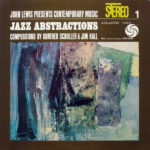 John Lewis, Gunther Schuller, Jim Hall – John Lewis Presents Contemporary Music 1: Jazz Abstractions: Compositions by Gunther Schuller & Jim Hall
John Lewis, Gunther Schuller, Jim Hall – John Lewis Presents Contemporary Music 1: Jazz Abstractions: Compositions by Gunther Schuller & Jim Hall
Recorded just prior to the session for Ornette’s own Free Jazz album, with Eric Dolphy appearing on both albums. Jim Hall would work with Coleman for the Science Fiction sessions years later (though his contributions were diverted to the archival Broken Shadows disc). Co-leaders Lewis and Schuller were early advocates for Ornette’s music, and this disc appeared on Ornette’s current label Atlantic. Ornette also performed in a concert of Schuller’s compositions in 1960. This is “third stream” music of a high caliber. Ornette is hardly at the center of the music, but, regardless, this is excellent stuff (the two tracks with Ornette are included on the Beauty Is a Rare Thing box set). This type of music — the strings on “Abstraction” especially — seems to have influenced Ornette’s own “classical” compositions in the coming years.
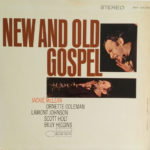 Jackie McLean – New and Old Gospel
Jackie McLean – New and Old Gospel
Louis Armstrong – Louis Armstrong and His Friends (“We Shall Overcome,” “Give Peace a Chance”)
Alice Coltrane – Universal Consciousness (string transcriptions: “Universal Consciousness,” “Oh Allah,” “Hare Krishna”) [version of “Oh Allah” appears on the compilation Reflection on Creation and Space (A Five Year View)]
Claude Nougaro – Femmes et famines (“Gloria”)
Charlie Haden – Closeness (“O.C.”)
Charlie Haden – The Golden Number (“The Golden Number”)
 James Blood – Tales of Captain Black
James Blood – Tales of Captain Black
Of all Ornette’s appearances as a sideman, Tales of Captain Black is probably the most essential. All the performers were in Ornette’s band, the music is “Harmolodic,” Ornette and his manager co-produced the album, and Ornette is a dominant force as a performer — this is practically a Coleman album! Though James “Blood” Ulmer turns in a great performance too. The music is skronky, loose, yet nimble and purposeful. Although Ulmer was in Coleman’s early Prime Time band, and even lived in Ornette’s Artists house loft for a while, this is the only officially-released recording of the two performing together.
Jamaaladeen Tacuma – Renaissance Man (“Dancing in Your Head”)
Cosmetic with Jamaaladeen Tacuma – So Tranquilizin’ (“About the Money”)
Jayne Cortez and The Firespitters – Maintain Control (“No Simple Explanations”)
Al MacDowell – Time Peace (“Come See Tomorrow”)
Grateful Dead – Live at Oakland-Alameda County Coliseum on 1993-02-23 [bootleg] (“Drums,” “Space,” “The Other One,” “Stella Blue,” “Turn On Your Lovelight,” “Brokedown Palace”)
Julian Schnabel – EXCAVATION Unauthorized Cut-Up Vol 1 (“Apartment #9” [a/k/a “Untitled”)
Bruce Hornsby – Intersections (1985-2005) (“Hop / Skip and Jump”)
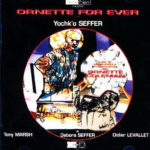 Yochk’o Seffer – Ornette For Ever
Yochk’o Seffer – Ornette For Ever
Geri Allen – Eyes… In the Back of Your Head (“Vertical Flowing,” “The Eyes Have It”)
Rolf Kühn & Friends – Affairs (“The Vertical Circle”)
Eddy Grant – Hearts and Diamonds (“Don’t Back Down”)
Joe Henry – Scar (“Richard Pryor Addresses a Tearful Nation,” “Richard Pryor Reprise”)
Lou Reed – The Raven (“Guilty [sung]”)
Sonny Rollins – Road Shows, Vol. 2 (“Sonnymoon for Two”)
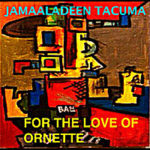 Jamaaladeen Tacuma – For the Love of Ornette
Jamaaladeen Tacuma – For the Love of Ornette
Listing of “Classical” Compositions
Ornette wrote numerous “classical” compositions, though he only recorded and released some of them under his own name. A few were written specifically to qualify him for exemptions to protectionist British musicians union regulations when touring. What follows is a listing of these compositions — as complete as possible, but likely still incomplete. Some of these compositions exist in multiple variations, but are only listed here once.
“Dedication to Poets and Writers”
“Forms and Sounds”
“City Minds and Country Hearts”
“Saints and Soldiers”
“Space Flight”
“Inventions of Symphonic Poems”
“Emotion Modulation”
“Sun Suite of San Francisco”
“Skies of America”
“Prime Design / Time Design”
“Sacred Mind of Johnny Dolphin”
“In Honor of NASA and Planetary Soloist”
“The Country That Gave the Freedom Symbol to America”
“Architecture in Motion”
“Notes Taking”
“Trinity”
“When the River Overflows”
Key Players
Geri Allen (piano) = GA
Ed Blackwell (drums) = EB
Bobby Bradford (trumpet) = BB
Don Cherry (trumpet, cornet) = DC
Gregory Cohen (bass) – GC
Denardo Coleman (drums) = DOC
Charles Ellerbee (guitar) = CE
Tony Falanga (bass) = TF
Jimmy Garrison (bass) = JG
Charlie Haden (bass) = CH
Billy Higgins (drums) = BH
David Izenzon (bass) = DI
Al MacDowell (bass) = AM
Bern Nix (guitar) = BN
Ronald Shannon Jackson (drums) = RSJ
Elvin Jones (drums) = EJ
Scott LaFaro (bass) = SL
The Master Musicians of Jajouka [also spelled/transliterated “Joujouka”] = MMJ
Charles Moffett (drums) = CM
Charnett Moffett (bass) = ChM
Dewey Redman (tenor saxophone) = DR
Chris Rosenberg (guitar) = CR
Badal Roy (tabla, percussion) = BR
Jamaaladeen Tacuma (Rudy MacDaniel) (bass) = JT
Chris Walker (bass, keyboards, vocals) = ChW
Ken Wessel (guitar) = KW
Calvin Weston (drums) = CW
Web Sites
Discography in Italian (translated)
Celebrate Ornette – Official web site run by Ornette’s estate, but, at this time, mostly promoting a particular tribute concert recording.
Harmolodic.com – Archived official web site (now defunct)
Ornette Coleman’s Harmolodic Universe
AllAboutJazz Ornette Photo Archive
Other Guides:
The Popdose Guide to Ornette Coleman
Ornette Coleman: Barry Witherden’s The Wire Primer
Howard Mandel’s 10 Album Introductory Guide
Piero Scaruffi’s Guide to Ornette Coleman
Ornette Coleman (AllAboutJazz)
An Essential Guide to Ornette Coleman
The Shape of Jazz to Come: Albums You Need to Hear
How Ornette Coleman’s Prime Time Broke the Rules and Influenced Generations
Harmolodic Hero: A Friend Pays Tribute to Ornette Coleman
Rock Listener’s Guide To Jazz Music: Ornette Coleman (translated)
Secondhand Songs Entry – information about cover versions of Ornette’s compositions
Ornette’s Tunes: The Compositions of Ornette Coleman (note: this list is not exhaustive)
Books:
Core library:
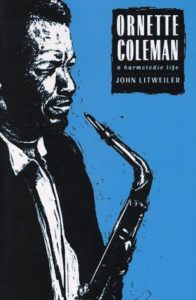 Ornette Coleman: A Harmolodic Life by John Litweiler – Well-rounded biography of Ornette published in the early 1990s (so it naturally omits the last part of his life). Very even-handed and packed with information, this is an excellent place to turn if you want to know more about Ornette’s life. This is the go-to resource for biographical information about Ornette.
Ornette Coleman: A Harmolodic Life by John Litweiler – Well-rounded biography of Ornette published in the early 1990s (so it naturally omits the last part of his life). Very even-handed and packed with information, this is an excellent place to turn if you want to know more about Ornette’s life. This is the go-to resource for biographical information about Ornette.
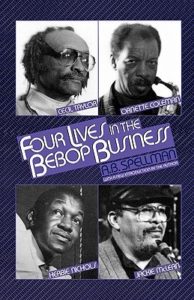 Four Lives in the Bebop Business by A.B. Spellman [has been reprinted under various alternate titles] – Includes a chapter on Ornette. This book is built around lengthy interview(s), and was one of the first in-depth accounts of Ornette and his relationship to the music business. Spellman was part of the Black Arts Movement.
Four Lives in the Bebop Business by A.B. Spellman [has been reprinted under various alternate titles] – Includes a chapter on Ornette. This book is built around lengthy interview(s), and was one of the first in-depth accounts of Ornette and his relationship to the music business. Spellman was part of the Black Arts Movement.
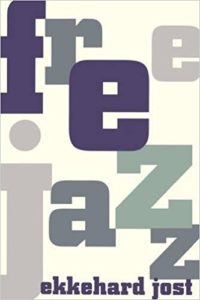 Free Jazz by Ekkehard Jost – Includes a chapter on Ornette, briefly summarizing his polarizing appearance on the jazz scene then proceeding to a detailed (and trustworthy) analysis of his improvising style and compositional forms, at least into the 1960s. Ornette’s chapter dives deep into musical theory (more so than other chapters), which may make this less user-friendly. But musicians can learn a lot about Ornette’s specific techniques.
Free Jazz by Ekkehard Jost – Includes a chapter on Ornette, briefly summarizing his polarizing appearance on the jazz scene then proceeding to a detailed (and trustworthy) analysis of his improvising style and compositional forms, at least into the 1960s. Ornette’s chapter dives deep into musical theory (more so than other chapters), which may make this less user-friendly. But musicians can learn a lot about Ornette’s specific techniques.
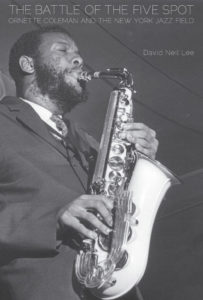 The Battle of the Five Spot: Ornette Coleman and the New York Jazz Field by David Lee – A short but very intriguing study (based on the theories of sociologist Pierre Bourdieu) about Ornette’s historic and polarizing stand at New York City’s Five Spot Cafe, and the time immediately leading up to it. What makes this book unique is that it isn’t just a biography or an analysis of musical theory but rather situates Ornette in a field that includes critics, listeners, club owners, record producers, etc. and tries to explain how Ornette’s historical legacy was legitimized and consecrated via that field (while other performers’ were not). Not as widely available as some other Ornette books, this is worth tracking down (particularly the revised third edition). For a shorter, cognitivist analysis of essentially the same topic, see “Far Out: Intentionality and Image Schema in the Reception of Early Works by Ornette Coleman.” See also “Free Jazz and the French Critic,” This Is Our Music: Free Jazz, the Sixties, and American Culture and Noise: The Political Economy of Music
The Battle of the Five Spot: Ornette Coleman and the New York Jazz Field by David Lee – A short but very intriguing study (based on the theories of sociologist Pierre Bourdieu) about Ornette’s historic and polarizing stand at New York City’s Five Spot Cafe, and the time immediately leading up to it. What makes this book unique is that it isn’t just a biography or an analysis of musical theory but rather situates Ornette in a field that includes critics, listeners, club owners, record producers, etc. and tries to explain how Ornette’s historical legacy was legitimized and consecrated via that field (while other performers’ were not). Not as widely available as some other Ornette books, this is worth tracking down (particularly the revised third edition). For a shorter, cognitivist analysis of essentially the same topic, see “Far Out: Intentionality and Image Schema in the Reception of Early Works by Ornette Coleman.” See also “Free Jazz and the French Critic,” This Is Our Music: Free Jazz, the Sixties, and American Culture and Noise: The Political Economy of Music
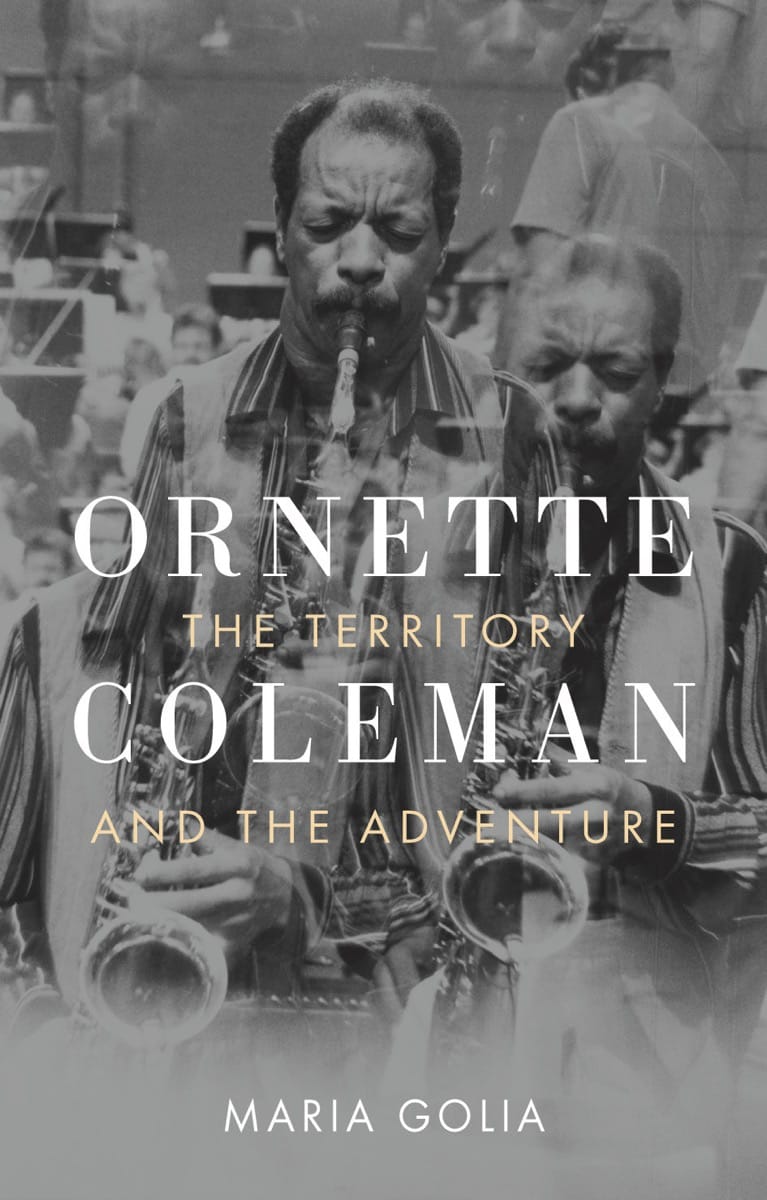 Ornette Coleman: The Territory and the Adventure by Maria Golia – (Interview with Maria Golia) – Golia’s book is not really a biography so much as it is a synthesis of the various biographies of Coleman that preceded hers. There are two things that distinguish this book from others on Coleman. The first is a contextual focus on his formative years growing up in Fort Worth, Texas and the variety of musical and lived experiences that shaped his compositional and improvisational processes. The second is her focus on his 1980s relationship with members of the Institute of Ecotechnics (especially the influence of R. Buckminster Fuller) and how it forms a through-line to his entire musical corpus. A musicological approach is eschewed for the most part, but book does feature one of the most forward explanations of Coleman’s harmolodic theory.
Ornette Coleman: The Territory and the Adventure by Maria Golia – (Interview with Maria Golia) – Golia’s book is not really a biography so much as it is a synthesis of the various biographies of Coleman that preceded hers. There are two things that distinguish this book from others on Coleman. The first is a contextual focus on his formative years growing up in Fort Worth, Texas and the variety of musical and lived experiences that shaped his compositional and improvisational processes. The second is her focus on his 1980s relationship with members of the Institute of Ecotechnics (especially the influence of R. Buckminster Fuller) and how it forms a through-line to his entire musical corpus. A musicological approach is eschewed for the most part, but book does feature one of the most forward explanations of Coleman’s harmolodic theory.
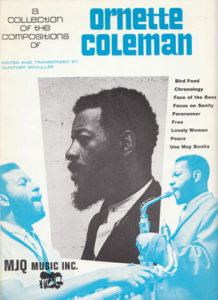 A Collection of the Compositions of Ornette Coleman – A set of ten transcriptions by Gunther Schuller of recordings from Ornette’s first two Atlantic albums, plus an important Preface by Schuller (later reprinted in Musings). This is somewhat like a “fake book” in that these are not published scores written out by Coleman himself, or under his direction, but rather involve judgment calls by the transcriber to convey in standard notation what were improvised performances in a recording studio. Unlike a later collection from the same publisher, these transcriptions cover the entire recorded performances on each of the instruments from beginning to end. Although not crucial for appreciating Ornette’s music, this publication was historically significant in terms of indicating that Ornette’s music was worthy of serious study. This publication is long out of print.
A Collection of the Compositions of Ornette Coleman – A set of ten transcriptions by Gunther Schuller of recordings from Ornette’s first two Atlantic albums, plus an important Preface by Schuller (later reprinted in Musings). This is somewhat like a “fake book” in that these are not published scores written out by Coleman himself, or under his direction, but rather involve judgment calls by the transcriber to convey in standard notation what were improvised performances in a recording studio. Unlike a later collection from the same publisher, these transcriptions cover the entire recorded performances on each of the instruments from beginning to end. Although not crucial for appreciating Ornette’s music, this publication was historically significant in terms of indicating that Ornette’s music was worthy of serious study. This publication is long out of print.
 This Is Our Music: Free Jazz, the Sixties, and American Culture by Iain Anderson – A good academic book that contextualizes the competing interests that grounded the rise of Ornette and the larger “free jazz” movement. Actually, this book, along with a few others written around the same time, performs a valuable service in explaining how cold war politics shaped the economics of the jazz industry more than many critics and listeners had generally acknowledged. It further offers a detailed analysis of the contradictions and challenges of the black nationalism movement that dovetailed with free jazz practice for a time. It also importantly chronicles how, on the basis of the similarities between free jazz of the likes of Ornette and modern classical music, free jazz performers migrated to academic positions and increasingly relied on grant funding, and how that funding may have shaped (or limited) performers who relied on such funding. The book frames many of these struggles in ways similar to Leon Trotsky’s “Art and Politics in Our Epoch” (1938) and Merton’s Strain Theory. A bit dry in tone, but packed with detail and useful citations. (review, review 2).
This Is Our Music: Free Jazz, the Sixties, and American Culture by Iain Anderson – A good academic book that contextualizes the competing interests that grounded the rise of Ornette and the larger “free jazz” movement. Actually, this book, along with a few others written around the same time, performs a valuable service in explaining how cold war politics shaped the economics of the jazz industry more than many critics and listeners had generally acknowledged. It further offers a detailed analysis of the contradictions and challenges of the black nationalism movement that dovetailed with free jazz practice for a time. It also importantly chronicles how, on the basis of the similarities between free jazz of the likes of Ornette and modern classical music, free jazz performers migrated to academic positions and increasingly relied on grant funding, and how that funding may have shaped (or limited) performers who relied on such funding. The book frames many of these struggles in ways similar to Leon Trotsky’s “Art and Politics in Our Epoch” (1938) and Merton’s Strain Theory. A bit dry in tone, but packed with detail and useful citations. (review, review 2).
 Miles, Ornette, Cecil: Jazz Beyond Jazz by Howard Mandel – Written by respected critic/writer — and unabashed Ornette superfan — Howard Mandel, this book treats a few important jazz figures. The part on Ornette is in-depth, sympathetic and detailed, if a little scattershot.
Miles, Ornette, Cecil: Jazz Beyond Jazz by Howard Mandel – Written by respected critic/writer — and unabashed Ornette superfan — Howard Mandel, this book treats a few important jazz figures. The part on Ornette is in-depth, sympathetic and detailed, if a little scattershot.
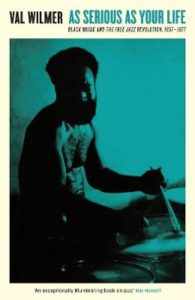 As Serious As Your Life: The Story of the New Jazz by Valerie Wilmer [has been reprinted with the alternate subtitles John Coltrane and Beyond and Black Music and the Free Jazz Revolution, 1957-1977] — Really a collection of essays, including biographical chapters on Ornette as well as frequent collaborator Ed Blackwell, this book contains extensive original research and first-hand accounts of the “free jazz” movement. Though it does often veer into hagiography, and the chapter on Ornette is now rather redundant in view of later publications about him.
As Serious As Your Life: The Story of the New Jazz by Valerie Wilmer [has been reprinted with the alternate subtitles John Coltrane and Beyond and Black Music and the Free Jazz Revolution, 1957-1977] — Really a collection of essays, including biographical chapters on Ornette as well as frequent collaborator Ed Blackwell, this book contains extensive original research and first-hand accounts of the “free jazz” movement. Though it does often veer into hagiography, and the chapter on Ornette is now rather redundant in view of later publications about him.
Other books:
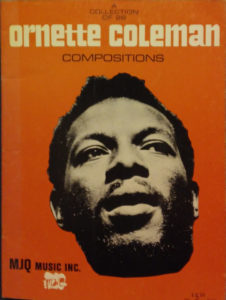 A Collection of 26 Ornette Coleman Compositions – MJQ Music Inc. published this collection of transcriptions in 1968, focusing on material from the Atlantic albums. It has more but different transcriptions than the ones by Gunther Schuller that MJQ Music published in 1961 as A Collection of the Compositions of Ornette Coleman. These particular transcriptions are sort of “abridged” ones that focus just on the head melodies by the lead soloist. Margo Guryan, who worked with Ornette at the 1959 Lenox School of Jazz, adds lyrics to a couple songs. Long out of print, these score publications are still available in some libraries. It is also worth noting that some writers through the years have included their own independent transcriptions of selected passages of Coleman recordings to illustrate certain points, usually in the context of academic writings.
A Collection of 26 Ornette Coleman Compositions – MJQ Music Inc. published this collection of transcriptions in 1968, focusing on material from the Atlantic albums. It has more but different transcriptions than the ones by Gunther Schuller that MJQ Music published in 1961 as A Collection of the Compositions of Ornette Coleman. These particular transcriptions are sort of “abridged” ones that focus just on the head melodies by the lead soloist. Margo Guryan, who worked with Ornette at the 1959 Lenox School of Jazz, adds lyrics to a couple songs. Long out of print, these score publications are still available in some libraries. It is also worth noting that some writers through the years have included their own independent transcriptions of selected passages of Coleman recordings to illustrate certain points, usually in the context of academic writings.
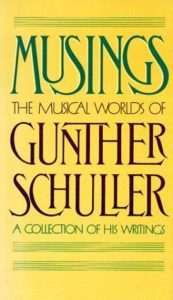 Musings by Gunther Schuller – Includes reprints of Schuller’s entry on Ornette in the New Grove Dictionary of American Music (which was subsequently updated by Barry Kernfeld) and his preface to a collection of transcriptions of ten of Ornette’s compositions (all ones recorded for Atlantic) published by MJQ Music Inc. in 1961. While both are somewhat obsolete now, they were significant at the time for lending legitimacy and credibility to Ornette’s music. Schuller’s commentaries also foreshadowed the way free jazz would align itself with “highbrow” cultural institutions in the coming years.
Musings by Gunther Schuller – Includes reprints of Schuller’s entry on Ornette in the New Grove Dictionary of American Music (which was subsequently updated by Barry Kernfeld) and his preface to a collection of transcriptions of ten of Ornette’s compositions (all ones recorded for Atlantic) published by MJQ Music Inc. in 1961. While both are somewhat obsolete now, they were significant at the time for lending legitimacy and credibility to Ornette’s music. Schuller’s commentaries also foreshadowed the way free jazz would align itself with “highbrow” cultural institutions in the coming years.
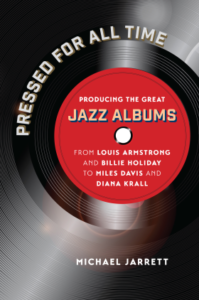 Pressed for All Time: Producing the Great Jazz Albums From Louis Armstrong and Billie Holiday to Miles Davis and Diana Krall by Michael Jarrett – A collection of interviews with jazz producers that includes material from John Snyder, who ran the Artists House label and was Ornette’s producer and manager for a while. Excerpt available here: “Ornette, John Snyder & the Meaning of Production” (see also the interview with Snyder [not in this book]: “Ethics, Soul and a Conscience . . . in the Music Industry?”)
Pressed for All Time: Producing the Great Jazz Albums From Louis Armstrong and Billie Holiday to Miles Davis and Diana Krall by Michael Jarrett – A collection of interviews with jazz producers that includes material from John Snyder, who ran the Artists House label and was Ornette’s producer and manager for a while. Excerpt available here: “Ornette, John Snyder & the Meaning of Production” (see also the interview with Snyder [not in this book]: “Ethics, Soul and a Conscience . . . in the Music Industry?”)
Free Jazz/Black Power by Philippe Carles and Jean-Louis Comolli
Going for Jazz: Musical Practices and American Ideology by
Nicholas Gebhardt
The Freedom Principle: Jazz After 1958 by John Litweiler
Black Music by LeRoi Jones [Amiri Baraka]
Flow, Gesture, and Spaces in Free Jazz: Towards a Theory of Collaboration by Guerino Mazzola, Paul B. Cherlin, et al.
Free Jazz, Harmolodics, and Ornette Coleman by Stephen Rush
Ornette Coleman: His Life and Music by Peter Niklas Wilson
Experiencing Ornette Coleman: A Listener’s Companion
by Michael Stephans
Ornette Coleman (Jazz Masters Series) by Barry McRae
Ornette Coleman: Music Always by Steve Day
Ornette Coleman by Claire O’Neal – Biography intended for young readers
Ornette Coleman, 1958-1979: A Discography by David Anthony Wild and Michael Cuscuna – at one time this was the definitive Coleman discography, but it is now basically obsolete
Music Universe, Music Mind: Revisiting the Creative Music Studio, Woodstock, New York by Robert E. Sweet – A history of the Creative Music Studio/Creative Music Foundation, an educational organization co-founded by Karl Berger, Ingrid Sertso, and Ornette.
Notes and Tones: Musician-to-Musician Interviews by Arthur Taylor
Free Spirits: Annals of the Insurgent Imagination, Paul Buhle (editor) – contains an essay by Ornette
Ornette Coleman: Klang der Freiheit by Christian Broecking – Collection of interviews (in German).
OpenLibrary Subject Matter Entries
Selected Articles:
The Other’s Language: Jacques Derrida Interviews Ornette Coleman, 23 June 1997
Sound Territory: The Genius of Ornette Coleman
Dancing in His Head: The Evolution of Ornette Coleman’s Music and Compositional Philosophy
Far Out: Intentionality and Image Schema in the Reception of Early Works by Ornette Coleman.
Ornette Coleman, Through the Systemic Functional Linguistics Lens
Ornette Coleman, Vanishing Mediator
Ornette Coleman and the Circle With a Hole in the Middle
Bern Nix: A History In Harmolodics
Regendering Jazz: Ornette Coleman and the New York Scene in the Late 1950s
Film/Video/TV:
Improvisations (1963)
O.K. End Here (1963)
David, Moffett, and Ornette [AKA The Ornette Coleman Trio] (1966)
Who’s Crazy? (1966)
Chappaqua (1967) – An alternate version of the film with audio remixed by C. Spencer Yeh in 2015 replaced the original soundtrack with Ornette’s unused soundtrack. Ornette appears as an actor in the original film.
Population Explosion (1968)
Communication Explosion (1968)
Run (1971)
Saturday Night Live (1979)
Boxoffice (1982)
Ornette: Made in America (1985)
Stadtgarten, Cologne (1987)
Naked Lunch (1991)
Warsaw Jazz Jamboree 1993 (1993)
The Simpsons, “Barting Over” (2003) – Ornette’s likeness appears somewhat in the background.
*Much of Ornette’s soundtrack work has never been released in stand-alone audio format, and, for that matter, some of the films and TV programs he provided soundtrack music for are unavailable in any format.
Curators’ Picks
Ten Favorite Albums:
Syd (listed preferentially):
This is Our Music [1961]
Science Fiction [1972]
Town Hall, 1962 [1965]
Chappaqua Suite [1967]
The Music of Ornette Coleman [1967]
Friends and Neighbors: Ornette Live at Prince Street [1970]
The Shape of Jazz to Come [1959]
At the “Golden Circle” Stockholm, Volume Two [1966]
Change of the Century [1960]
Song X [1986]
Prime Design / Time Design [1986] (I’m cheating by listing 11 albums, but I really like this too)
Bruno (listed preferentially):
Free Jazz: A Collective Improvisation [1961]
Dancing in Your Head [1977]
Science Fiction [1972]
Opening the Caravan of Dreams [1986]
Friends and Neighbors: Ornette Live at Prince Street [1970]
Of Human Feelings [1982]
Body Meta [1978]
Prime Design / Time Design [1986]
This is Our Music [1961]
Ornette at 12 [1969]
Patrick:
TBA
Also Try:
Charlie Parker – Yardbird Suite: The Ultimate Charlie Parker Collection
Cecil Taylor – Jazz Advance and At Newport
John Coltrane & Don Cherry – The Avant-Garde
Paul Bley Quintet – Barrage
The Bill Dixon Orchestra – Intents and Purposes
Manfred Schoof – European Echoes
Don Cherry – “mu” First Part and “mu” Second Part
Charlie Haden – Liberation Music Orchestra
LaSalle Quartett – Neue Wiener Schule – Die Streichquartette
Old and New Dreams – Old and New Dreams
Music Revelation Ensemble – No Wave
Ronald Shannon Jackson and The Decoding Society – Mandance
Derek Bailey, Jamaaladeen Tacuma & Calvin Weston – Mirakle
Books:
R. Buckminster Fuller – Nine Chains to the Moon
William S. Burroughs – Naked Lunch
Anthony Braxton – Triaxium Writings
Film:
Spaceship Earth – This documentary features a number of associates who shared many of the same ideals and influences as Ornette; he wrote songs in honor of some of them. Numerous people in this film were also involved with the Caravan of Dreams. Basically this is a snapshot of a vision of space-age utopian capitalism that Ornette largely shared.


